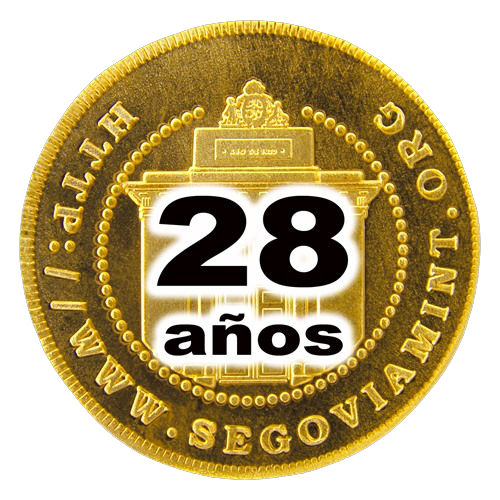News

Guided Mint tour for the numismátic Association Reverso y Anverso
Published 15/04/2023 00:00
Around 30 members of the Reverso y Anverso Association, from various points around Spain, were given a guided tour of the Mint, offered by Glenn Murray on Saturday, April 15. Later, after apetizers at the Mint’s Ingenio Chico terrace, the group had lunch at Casares restaurant. (video)

Murray will explain overdates on Segovia cincuentin coins in the numismatic megaevent in Santo Domingo, June 28, 2023
Published 14/04/2023 00:00
We have located around 221 different cincuentin, or 50 real pieces, of 20 different dates. Of these dates, which run from 1609 to 1682, 9 years are overdates. Some of these overdates have been interpreted erroneously in catalogs and auctions. In this study, we have developed a map of roller-dies, examining not only the date itself, but other factors as well in order to correctly trace the origin of each die.

Call for the 30th General Assembly of the Association, 2023
Published 11/04/2023 00:00
The 30th General Assembly of the Association will take place in the old Casa de Socorro, on Arias Davila Street, number 1, on April 29th, 2023, at 12:00 first call and 12:30 second call.

The Association is a backer of the Santo Domingo MMXXIII numismatic megaevent
Published 06/04/2023 00:00
After Potosi, Arequipa and Cartagena de Indias, the IV Numismatic Megaevent will take place in Santo Domingo, the Dominican Republic, from the 28th of June til the 2nd of July. Several members of Friends of the Segovia Mint will be present. Murray is the vicepresident for Spain, of the 26 countries participating.

GUIDE to documents on COINS, MINTS and MONETARY POLICY in the section Consejo y Juntas de Hacienda of the Simancas Archive
Published 05/04/2023 00:00
The Association is now distributing the inventory of documents that Glenn Murray prepared for the Madrid Mint Foundation (RCM-FNMT) between the years 1989 and 2001, of one of the sections of the Simancas General Archive: Consejo y Juntas de Hacienda (CJH). The inventory is made up of 6,135 individual entrys, comprising 2,101 pages, running from the year 1512 until 1705, which can be downloaded free of charge. (download free)

Visit the Segovia Mint Museum, with Glenn Murray
Published 25/03/2023 00:00
On the ocasion of the Convention in Segovia of the Asociacion Española de Numismaticos Profesionales, our member, bloger and investigator, Adolfo Ruiz Calleja, brought a group of his supporters to visit the Segovia Mint Museum, Guided by Gloenn Murray. (video).

HANS KHEVENHÜLLER. Renovation of his tomb in the Church of the Jeronimos, in Madrid. Conferences, publication and visit to the Segovia Mint.
Published 12/03/2023 00:00
Khevenhüller was the Imperial ambassador in the Court of Phillip II and one of the king’s closest counselors. It was Khevenhüller that organized and carried out the entire operation to introduce the coin rolling mills to Spain starting in 1580, through the construction of the plant until 1588, with a team of 14 german technicians under his comand. Friends of the Segovia Mint participated in the event, and invited the attendees to visit this grand project of Khevenhüller’s in Segovia. (Link to pdf) (video)

Unciphering numismatic mysteries with historic documentation. – Conference . Murray
Published 31/08/2022 00:00
Dr. Murray participates in the II Cycle of Conferences of the UNAM, México, - Current debates on monetary history. (Wednesday, 13-August-2022, 12:00 – 14:00.

Potosi – Conference: “The second Potosí Mint, according to the plans for its construction in the General Archive of Seville”.
Published 29/07/2022 00:00
To honor the 249th Aniversary of the Potosí Mint, Glenn Murray has been invited to participate in the talks, expanding on a topic which comes from his book publishen in Potosí in 2016.

437th anniversary of the first trial coining in the Royal Segovia Mill Mint.
Published 09/07/2022 00:00
Today the Association celebrates the 437th anniversary of the first trial coining in the Royal Segovia Mill Mint. This event took place in the presence of especially famous people barely one month after the industrial Convoy arrived in Segovia from the Mint in Hall in Tyrol, where the machinery was made. (see image)

We support the initiative of Bolivia to have an important Mint document included in the International Memory of the World Register UNESCO
Published 04/07/2022 00:00
We have sent a letter of support to the Potosí Mint – Cultural Foundation of the Central Bank of Bolivia, as requested, to have the ‘list of instruments sent from Spain (1750 and 1758) to equip the new Mint, in the above stated World Register. The document is held in the Potosi Mint Archive, and we emphasize its importance. Murray gave a ‘virtual’ conference on this document at the Potosi Mint in July of 2021.

Numismátics, much more than just collecting coins. – Glenn Murray
Published 30/06/2022 00:00
Story of Murray’s life, from starting as a coin collector at 7 years old, to working as a photographer in Perú, and restoring the Royal Segovia Mill Mint in Spain. Link to journal: Pgs. 43-56.

Meeting in the Assembly of Castile and Leon about the Mint Museun and Aqueduct
Published 22/06/2022 00:00
The president of the Associatión, Glenn Murray, held a meeting today in Valladolid regarding possible improvements for the Segovia Mint Museum, and in his capacity as the EUROPA NOSTRA award recipiant of the European Union, regarding his proposals for the protection and conservation of the Segovia Aqueduct. Present in the meeting were the Vice-counsil for Cultural Action, Ms. Mar Sancho, and the Director General for Cultural Heritage, Mr. Juan Carlos Prieto. (click links to see reports presented)

VIDEO of the inaugural conference of the 487 anniversary of the Mexican Mint by Dr. Murray
Published 11/05/2022 00:00
Dr. Murray gives the inaugural conference at the celebration of the Mexico City Mint, with photographs of his private visit to the Apartado Plant when coins were still being struck there in 1985. Recognition for participating. YouTube VIDEO

Dr. Murray will give the inaugural presentation at the 487 Anniversary of the Mexico Mint
Published 05/05/2022 00:00
“Remembrances, the Apartado Mint when it was still striking coins”, is the title of Dr. Murray’s inaugural presentation for the grand anniversary of the Mexican Mint. The presentation consists of 47 photos (all in the technology section of our website) which Murray took on his private visit to the Mexican Mint at the Apartado division in 1985, when coins were still being struck there.

LUNCH AT THE INGENIO CHICO restaurant, after the General Assemblies of the Association
Published 02/04/2022 00:00
After the General and Extraordinary Assemblies on April 2, 2022, the members of the Board of Directors and several other members of the Association made a technical visit to the Mint Museum, after which they they had a festive lunch at the Mint’s Ingenio Chico restaurant, located in the building where the famous cincuentin and centen coins were struck.

CALL FOR THE GENERAL AND EXTRAORDINARY ASSEMBLY - Abril 2, 2022
Published 18/03/2022 00:00
We have sent, via postal mail, to all members on the 18th of March, 2022, the Yearly Report for 2021, and the call to the General and Extraordinary Assembly which will take place on April 2, 2022.

NEW FREE PUBLICATION: “Proposal for the reactivation in 1750 of the hydraulic Mint in Cuenca”
Published 07/03/2022 00:00
The mechanized Mint at Cuenca was built in 1661, using as a technological model Phillip II’s hydraulic Mint in Segovia. This proposal, dated in 1750, includes a detailed description and inventory of everything needed to put the Mint, closed and striped of machinery in 1728, back in operation. The author was the partner in Cuenca of Nicolas Peinado, engineer in charge of mechanizing the Mexico Mint in 1730. The document is an important link between these mints as well as the Potosi Mint, whose rolling mills were built in Seville in 1750. [Download free]

Important donation by Emilio Ortiz for the Association’s library
Published 02/03/2022 00:00
From Puerto Rico, the famous numismatist Emilio Ortiz sends us the three volumes of his detailed study, of over 40 years, of cuartillos (1/4 real pieces) from the colonial and republican periods of all the Latin American Mints. A monumental study, profusely illustrated, it now forms part of the more than one thousand books which our Association currently has to help found the future numismatic library of the Segovia Mint Museum. Many thanks, Emilio!

WE ARE MEMBERS OF HISPANIA NOSTRA - These are our membership benefits.
Published 17/02/2022 00:00
FRIENDS OF THE SEGOVIA MINT continues as a member of HISPANIA NOSTRA, with membership number 1249. Our members enjoy free entrance to Spanish National Museums, and others. See all the advantages in this link.

Biographical data in WIKIPEDIA of Dr. Glenn Murray - President of the Association
Published 16/02/2022 00:00
Here is a direct link to the biographical data, and some publications of Dr. Glenn Murray, President of the Association. The Wikipedia listing was made by EUROPA NOSTRA after awarding the well known numismatist and founder of the Association with the Grand Prize for Cultural Heritage of the European Union in 2009.

WE PARTICIPATE IN THE 'MUCAIN' PROJECT for the construction of a Museum of the Galleon Route to the Indes.
Published 12/02/2022 00:00
The Friends of the Segovia Mint Association participates in the MUCAIN (Museum of the Galleon Route to Indies) Project, of Ricardo Férnandez González, for the construction of a Museum which explains in detail the treasure route to the Indes. VIDEO.

Book donations in Colombia for the library of Friends of the Segovia Mint
Published 10/12/2021 00:00
Various participants in the numismatic mega-event in Cartagena, Colombia, donate books for our Association’s library. Of special note are books on coinage of Chile, Peru, Mexico, El Salvador and Colombia. These books will be part of the content for the future numismatic library of the Museum of the Segovia Mint.

VIDEO of Dr. Murray's CONFERENCE in CARTAGENA DE INDIAS. "Spanish coinage, the increasing lack of care in its production..."
Published 06/12/2021 00:00
I. Preliminary virtual conference (18-sept-2021), "The roller mill coining at the Segovia Mint..." with lots of photos of machines and roller dies. II. Conference in person in Cartagena (2-dec-2021) during the numismatic mega-event in Colombia, about the increasing lack of care in the production: motives, consecuences and solutions, and the 'authorization' to strike coins with irrregular edges. Certificates: "Participación de Oro", y "Vicepresidentes Cartagena 2021".

THE CONSTANT DECLINE IN THE CARE OF HAMMER STRIKING SPANISH SILVER COINS. Murray's conference in Cartagena, Colombia
Published 02/12/2021 00:00
In his conferencia in Cartagena, Colombia, during the 3rd Numismatic Mega-event Cartagena 2021, Dr. Murray analizes the reasons that caused the decline in the form of coins struck by hammer at Spanish mints, the consequences and the solutions which finally put an end to the problem. Of special interest is an effort to solve this problem made in 1610, headed up by Diego de Astor, the inventor of the giant 50 real pieces, and engraver at the Segovia Mint, after which the Treasury retracted its order, and 'authorized' the rapid striking of deformed coins so as not to delay the king´s payments. [download free]

THE SCANDAL OF THE 1622 CINCUENTIN, by Glenn Murray (© 2021)
Published 26/10/2021 00:00
A true history taken directly from the Simancas Archive documents, about influential segovians and their experiences in the two Segovia Mints during the bonanza period of the principal industry of the city: coining. [Download free]

FRIENDS OF THE SEGOVIA MINT IN THE MEGAEVENT CARTAGENA-2021
Published 18/09/2021 00:00
Friends of the Segovia Mint is participating in the ‘3rd International Convention of Historians and Numismatists’. This year, after Potosí in 2016 and Arequipa in 2018, the event takes place in Colombia. Murray is the vice president for Spain and will give a conference titled: SPANISH SILVER COINS, THE DECLINING ROUNDNESS OF HAMMER STRUCK COINS: REASONS, CONSEQUENCES AND SOLUTIONS. We will have a special banner in the conference hall and several of our members will be present. Location: Intercontinental Hotel, Cartagena, Colombia, December 1 – 5, 2021.

NEW FREE PDF - AUCTIONS OF THE OLD MADRID, SEVILLE, SEGOVIA AND JUBIA MINTS
Published 05/09/2021 00:00
Our latest pdf is free to download, share and print. The auctioning of the old mints at Madrid, Seville, Segovia and Jubia (1866-1870). With interesting decriptions of the buildings. We launch this new publication in commemoration of the 16th anniversary of the signing of the restoration agreement for the restoration of the Segovia Mint on September 5, 2005. [Free download]

MURRAY REQUESTS HELP FROM UNESCO TO SAVE THE SEGOVIA AQUEDUCT
Published 15/08/2021 00:00
The president of the Friends of the Segovia Mint Association and Grand Prize winner of the EUROPA NOSTRA award for Cultural Heritage of the European Unión in 2009, Dr. Glenn Murray (video cleaning the observation look-out), has written a report for UNESCO in his capacity as a prize winning colaborator, on the alarming state of the Segovia Aqueduct. While 99% of the monument is in a realtively aceptable state of conservation, the bases of 3 columns are seriously deteriorated, and if one gives way, the entire monument could come crashing down due to the domino effect. See UNESCO pdf.

THE ASSOCIATION LAUNCHES ITS NEW WEB
Published 29/06/2021 00:00
After 24 years on internet, and being one of the first websites in Segovia (1997), the Association has now completely renovated its website. Thanks to the expertise of our programmer, Bernat Llabres, it is now possible to obtain information not available in the Mint museum, on any device anywhere. With more than 4,000 high quality images, the Association now takes the Segovia Mint to the entire world, offering a technical and scientific tour of the Mint, albeit virtual, that even the museum itself does not offer.

GUIDE TO MINT PRODUCTION DOCUMENTS IN THE SIMANCAS ARCHIVE
Published 22/04/2021 00:00
Our publication for 2021 is this guide to the accounting documents of mints in the General Archive of Simancas. We conisder this an authentic treasure map for research on all aspects of Spanish peninsular mints and truly hope it serves to inspire investigaions by collectors and historians alike. This guide can be downloaded, used and shared free of charge for everyone. [DOWNLOAD FREE]

WE ARE MEMBERS OF HISPANIA NOSTRA
Published 10/02/2021 00:00
See the advantages in 2021 for Hispania Nostra members in this link. We have just sent information to all members, via postal mail, regarding activities, accounting and the General Assembly.

TWO METERS OF WATER IN THE MUSEUM - ANOTHER FLOOD
Published 11/12/2020 00:00
Once again, the Mint is victim of the neglect by administrations in caring for the river. While some blame the CHD for not regulating the dam which sits above Segovia, others point to promises made by City Hall to un-block the river, and never kept. Please consult the Museum’s website for reopening dates.

Murray in México carries out research in the General Archive of the Nation
Published 14/11/2019 00:00
Murray carries out research in the principal mexican archive for mintage statistics. The Association has plans to publish mintage statistics in colaboration with Mexican authorities. Copies of our publications are donated to the libraries of the National Archive as well as the Mint Museum.

ROYAL FRAUD - OUR LATEST BOOK
Published 29/06/2019 00:00
Presenting the Association’s latest book: “ROYAL FRAUD…”. This is a true and documented historic narrative about the King’s coining experiments in his own private mint in Segovia. Secrets are revealed about an unknown royal scheme to strike debased coins. Official book presentation at the Royal Spanish Mint Museum in Madrid, on June, 29, 2019, with comentary in Adolfo Ruiz Calleja’s Blog (with Murray in photo) [LINK], and video-conference in ‘NNF Aprendiendo’ [LINK]. [© 2019, 15 x 21 cm, 296 pgs.] [BUY HERE]

OUR NEW BOOK - GUIDE TO THE MINT AND COINAGE OF SEGOVIA
Published 30/05/2018 00:00
Grand presentation, in the Conference Hall of Caja Segovia, on May 30. This new book is an updated version of our book from 2011 with photos of all the coins struck in Segovia. With 30% more pages, and descriptions of both mints, it’s the perfect reference to carry on a visit to the Mint Museum. [© 2018, 15 x 21 cm, 129 pgs.] [BUY HERE]

“The Tourism Potential of the Old Cuzco Mint” – Glenn Murray
Published 30/04/2018 00:00
Article by Glenn Murray in the UNAN NUMISMATIC journal, of the Unión Americana Numismática, in which Murray proposes the creation of a small Interpretrion Center of the Old Cuzco Mint in one of the small rooms of the Mint with door opening to the street. [Año IV. Nº. 23, March-April, 2018]. Link to journal: págs. 29-36.

NEW VERSION OF OUR COMIC WITH MORE PAGES
Published 29/01/2017 00:00
With the renewed help from the Segovian artist, Jose Orcajo, the Associatión has published an updated and enlarged version of our comic on the history of the mint. As with the first edition we published in 2002, the new comic is also available in Spanish and in English. [BUY HERE]

Celebration of the first international numismatic mega-event at the Potosí Mint, Bolivia
Published 23/10/2016 00:00
Numismatists from all over Latin America and much of Europe, get together at the Mint in Potosí, Bolivia, for activities which include conferences, visits, and presentations of new books, including 1,000 free samples of Friends of the Segovia Mint’s Bolivian edition of our book on the Potosí and Lima Mints. In the photo, Murray with Ruben Ruiz, museum director, and Jorge Proctor, the night of the gala dinner, at the entrance to the Mint.

We present our new book on the Mints of Potosi and Lima in the Ministry of Culture and Tourism, in Bolivia
Published 13/10/2016 00:00
The official presentation of the Bolivian edition of 1,000 copies of the Association’s latest book on the Mints of Potosi and Lima, takes place with the presence of the Minister and the Mayor of Potosí, in the headquarters of the Ministry for Culture and Tourism in la Paz, on October 10, 2016. [© 2016, 15 x 21 cm, 296 pgs.] [BUY HERE]

The Association present at the 480th anniversary celebration of the Mexico Mint
Published 11/05/2015 00:00
Friends of the Segovia Mint is present at the celebration at the Mexico City Mint on May, 11, 2015, where he gives a special presentation to the staff of the Museum at the Apartado Mint, with books on the Segovia Mint for each employee.

OUR NEW BOOK COMMEMORATES 400th ANNIVERSARY OF MADRID MINT
Published 07/11/2014 00:00
This definitive book on the quantities of coins struck at the Madrid Mint, is the Association´s way of celebrating the 400th anniversary of the Mint. Written by Dr. Glenn Murray, there are two book presentations: in Segovia at the Quintanar Palace, on November 5, and in Madrid at the AENP Numismatic Convention, on November 7. [© 2014, 15 x 21 cm, 187 pgs.] [BUY HERE]

WE OFFER LUNCH AND GUIDED MINT TOUR DURING NUMISMATIC CONVENTION
Published 11/05/2013 00:00
The first A.E.N.P. coin convention to be held in the restored Mint takes place on May 11. Friends of the Segovia Mint, has organized a guided tour of the building and a lunch in the Mint’s restaurant for our members and visiting friends.

IV ANNUAL SAN FRUTOS BENEFIT COIN STRIKING - 411 euros FOR THE AECC
Published 24/10/2012 00:00
Friends of the Segovia Mint giving the check for 411 euros to the Spanish Anti-Cancer Association. Proceeds came from the sale of San Frutos medals struck at the door of the Cathedral, below the San Frutos statue, on the eve of the Patron saint’s day, just before the turning of the page ceremony. Striking continues on San Frutos Day in our Association headquarters.

FREE MEDALS TOSSED INTO THE AIR - Celebrating 200 years of the Spanish Constitution - Aqueduct Plaza in Segovia
Published 23/08/2012 00:00
The Association celebrates the 200th anniversary of the Spanish Constitution (la Pepa) in Segovia, with the tossing into the air of a handfull of FREE MEDALS for the attending public, in the Azoguejo plaza beside the Aqueduct. VIDEO LINK

FREE MEDALS TOSSED INTO THE AIR - Celebrating 200 years of the Spanish Constitution - Main Plaza in Segovia
Published 23/08/2012 00:00
The Association celebrates the 200th anniversary of the Spanish Constitution (la Pepa) in Segovia, with the tossing into the air of a handfull of FREE MEDALS for the attending public, in the Plaza Mayor of Segovia. VIDEO LINK

MINT MUSEUM INAUGURATION WITH PANELS BY MURRAY (with videos)
Published 29/06/2012 00:00
Grand inauguration of the Mint Museum on June 29, 2012. The mint’s smithy and forge, as well as three large water wheels have been reconstructed. The exposition is composed of 50 didactic panels by Murray and the Association, and there is a concert in the evening. ENLACES VIDEOS: Room 1, Room 2, Room 2ª, Room 3, Room 4, Room 5, Room 6, ruedas hidráulicas.

THE ASSOCIATION REQUESTS ODYSSEY COINS FOR THE MINT MUSEUM
Published 13/03/2012 00:00
During the ‘5th Mint Day', which we celebrate this year in the Casa de los Picos, we announce our proposal to bring coins from the Odyssey to Segovia, holding a signature campaign. Our proposal receives immediate approval from politicians and Segovian society. The proposal with signatures, is delivered to the Ministry of Culture on March 13.

OUR COINING PERFORMANCE AND CUSTOM MADE DESIGNS - A SUCCESS
Published 15/02/2012 00:00
Aside from the three coining dies ordered by Sepulveda City Hall, and one by Segovia (Segovia-2016), we continue with new requests and issues. In 2008 we struck for Horizonte Cultural, in 2011 for Cuellar City Hall and the CEIP Peñascal school, and in 2012 for the Amanacer Association.

5th MINT DAY - COIN STRIKING AND BOOK PRESENTATION IN CASA DE LOS PICOS
Published 14/02/2012 00:00
The ‘5th Mint Day’ celebration, February 14, featured coining on our hammer press and presentation of our latest book, “The coins of Segovia…”, sponsored by Caja Rural and El Adelantado. The newspaper donates the set of coining dies they used for the series of medals they struck previously, to the Association.

Association member, Miguel Angel Cillanueva, presents his book on the accounting ledgers of the construction of the Royal Mill Mint, in Segovia (1583 – 1588)
Published 13/12/2011 00:00
Asociation member Miguel Angel Cillanueva, presents his book about the accounting ledgers of the construction of the Segovia Mint. His research was sponsored with a grant by Caja Segovia. The book analyzes in great detail the entirety of bundle 906 of the Tribunal Mayor de Cuentas section in the Simancas Archive, photocopied by Murray in 1995, who also assessed Cillanueva during the project.

SAN FRUTOS BENEFIT COIN STRIKING - 424 euros FOR APADEFIM
Published 24/10/2011 00:00
Once again, we strike medals for a special cause at the feet of San Frutos, above the entrance to the Cathedral, on the evening before the Patron Saint’s day. This year we collect 424 € for APADEFIM.

THE QUEEN OF SPAIN HANDS MURRAY THE EUROPA NOSTRA AWARD GRAND PRIZE
Published 25/11/2010 00:00
The President and Founder of the Association, Dr. Glenn Murray, recieves the Grand Prize, "European Union Award for Cultural Heritage / EUROPA NOSTRA", handed to him by the Queen of Spain, H.M. Doña Sofia, in a ceremony offered by HISPANIA NOSTRA and the Royal House, in the El Pardo Palace, for the Spanish award winners of 2009 and 2010. Murray was awarded the grand prize of 10.000€ in Taormina (Sicilia), Italy, in 2009.

II ANNUAL SAN FRUTOS BENEFIT COIN STRIKING - 573 euros FOR CARITAS
Published 24/10/2010 00:00
Friends of the Segovia Mint giving the check for 573 euros to Cáritas. Proceeds came from the sale of San Frutos medals struck at the door of the Cathedral, below the San Frutos statue, on the eve of the Patron saint’s day, just before the turning of the page ceremony. Striking continues on San Frutos Day in our Association headquarters.

EUROPA NOSTRA SPECIAL DELEGATES VISIT MINT UNDER CONSTRUCTION WITH MURRAY
Published 16/10/2010 00:00
A special delegation of EUROPA NOSTRA, which is visiting the award winning sites in Spain for 2009 and 2010, visits the Segovia Mint under construction, with Murray, a prize winner, who also offers them a guided tour of the city. The award ceremony will be in November, with the queen, at the El Pardo Palace.

Striking medals during the Festival of San Lorenzo, Segovia, 7-august-2010
Published 07/08/2010 00:00
The FRIENDS OF THE SEGOVIA MINT ASOCIATION takes its hammer striking coin press to different FESTIVALS and EVENTS, public and private, in the Province of Segovia. VIDEO LINK.

Medal striking during the Festival of the Fueros, in Sepulveda (Segovia), 2010
Published 17/07/2010 00:00
FOUR VIDEOS of Striking medals with the hammer press of the FRIENDS OF THE SEGOVIA MINT ASSOCIATION, in the Festival of the Fueros of 2010, in the Plaza of Spain, July 17, 2010. VIDEO-1, VIDEO-2, VIDEO-3, VIDEO-4.

MINT RECONSTRUCTION PHOTOS. We are currently posting unseen views of the work in progress on the website
Published 01/06/2010 00:00
With priviliged access, we have been able to fully document the most important parts of the building reconstruction. These images are posted on the Associacion’s website. (foto: Globos Borreal)

We launch our new die commemorating the Santa Agueda Festival of Zamarramala
Published 07/02/2010 00:00
Our in-house engraver and member Juan Jose Sanchez Castaño, has engraved a new obverse die for our hammer press. The new die is formally presented by Juanjo himself, at the Santa Agueda Festival on February 7, 2010, with the striking of our new pieces.

1st SAN FRUTOS BENEFIT COIN STRIKING - 561 euros FOR CARITAS
Published 24/10/2009 00:00
The Association strikes first issue commemorative San Frutos medals on October 24, eve of the Patron Saint’s Day, at the door to the Cathedral, just below the statue of San Frutos. The new die, was designed by our member Juan José Sánchez, and produced at the Hall in Tyrol Mint, in Austria. The medal has a latent image of the Saint’s book, so slightly moving the piece makes it appear as if the pages of the book are turning. This is our first “San Frutos Benefit Coin Striking”, this year taking in 561 euros for Caritas.

NEW FLYER PUBLISHED BY THE ASSOCIATION IN SPANISH AND ENGLISH
Published 28/08/2009 00:00
With the assistance of the Chamber of Commerce of Segovia, the Association publishes a special flyer about the cultural advantages in the restoration of the Segovia Mint towards the ‘Segovia-2016’ contest. 5,000 flyers are published in Spanish and another 5,000 in English, which Murray takes to the museums in Europe where he is investigating.

WE STRIKE MEDALS IN SEPULVEDA - 3 OBVERSES WITH NEW 4 MONUMENTS REVERSE
Published 10/07/2009 00:00
Once again, Sepulveda City Hall invites the Association to strike medals in the Fueros Festival. This year, we struck using combinations of one of the 3 previous obverse dies from Sepulveda, with the new reverse die of the 4 monuments, which carries the 2009 date.

MURRAY AWARDED THE 5th PEÑALOSA MEDAL - NOBLE LINEAGE
Published 27/06/2009 00:00
President of the Association, Dr. Glenn Murray, is awarded the V PEÑALOSA MEDAL, given by the Assembly of Noble Lineages of Segovia, in a ceremony held in the Sala Capitular of the Cathedral, with the presence of the Nobles, led by its Deputy Dean, Alfonso Gallego de Chávez, Marque of Quintanar. The medal, given in remembrance of D. Luis Felipe de Peñalosa, avid defender of Segovian Heritage, was awarded to Murray "Considering his defense of the Historic-Artistic heritage of Segovia, and especially the Mint".

GLENN MURRAY RECEIVES THE GRAND PRIZE EUROPA NOSTRA AWARD
Published 05/06/2009 00:00
The president of the Association, Glenn Murray, is selected as a Grand Prize winner of 10.000 euros in the prestigious European Union Prize for Cultural Heritage / EUROPA NOSTRA AWARDS 2009.in the category Individual Dedication, in Taormina (Sicilia) Italy. Murray, in his acceptance speach, donates the prize money in its entirety to the Friends of the Segovia Mint Association. The judges, presided over by Her Highness Doña Pilar de Borbon of Spain (photo), select Murray by unanimous decision, for his work towards restoring the Segovia Mint. In his acceptance speach, Murray donates the 10.000 euros to the Association. Murray is presented as a candidate for the prize by the Chamber of Commerce and Industry of Segovia. [Video of the award presentation]

MURRAY NAMED SEGOVIAN OF THE YEAR
Published 30/05/2009 00:00
Murray receives the SEGOVIAN OF THE YEAR award, given by the Segovian Center of Madrid, May, 30th, 2009, in the headquarters of the Center in Madrid. In the photo: the president of the Center, Antonio Horcajo, and the other award winner, Jesús Núñez.

WE PRESENT NEW BOOK AT CHAMBER OF COMMERCE
Published 15/02/2009 00:00
With a large turn out, during the 2nd ‘Mint Day’, held by the Association at the Chamber of Commerce, we present Murray’s new book, "Oldest industrial factory...". Published by the Chamber of Commerce, it contains the technical reasoning behind the proposal that the Segovia Mint be declared Industrial Heritage of Mankind, and was sent to administrations as well as the UNESCO. [Free book]

FIRST STRIKING NEW MEDAL ON 2nd MINT DAY - 4 MONUMENTS
Published 14/02/2009 00:00
The Association strikes the first medals with our new reverse die, 4 MONUMENTS, during the celebration of the 2nd anniversary of "Mint Day", February 14, 2009. The new die was designed by our engraver and member Juan Jose Sanchez, and carries the date 2009.

FIRST MINT DAY IN SEGOVIA. The Association celebrates one year of reconstruction work at the Mint
Published 14/02/2008 00:00
Big celebration in the Casa de los Picos on February 14, 2008, to commemorate the first anniversary of the start up of the Mint restoration. Friends of the Segovia Mint Assocciation invites all, with coin striking, free printed material and food and refreshments for everyone.

New headquarters for the Associación, on the Plaza de la Merced.
Published 20/11/2007 00:00
Friends of the Segovia Mint, with previous headquarters at Plaza Reina Doña Juana, opens its new location on the Plaza de la Merced, right next to the Church of San Andres. Big inauguration open-house celebration party on November 20, 2007, with coinstriking, projections, free printed materials and tapas and refreshments for all.

ASSOCIATION RECEIVES THE TIERRA DE SEGOVIA AWARD
Published 23/06/2007 00:00
The Segovian Center of Madrid celebrates its ‘Premios Tierra de Segovia, sus hijos y sus obras’, awards, giving the Association the ‘Fray Antonio de Villacastín’ award for restoration of Segovia heritage. Especially valued was: “the dedication and collective effort to recover this singular type of patrimony, towards which the Association has paid special attention, in a consistent manner, and finally seeing the project become a reality, saving this incomparable historic and architectonic monument, thanks to the member’s constant efforts”.

THE ASOCIATION STRIKES SEGOVIA 2016 MEDALS IN THE AZOGUEJO ON FULL MOON NIGHT
Published 01/06/2007 00:00
The association takes the hammer press to the Azoguejo on the nights of June 1 and 2, "1st Full Moon Night", so the public can strike their own medal of the Segovia-2016 candidature for European Capital of Culture.

WE STRIKE MEDALS AT THE GROUND BREAKING CEREMONY FOR MINT RESTORATION
Published 14/02/2007 00:00
Grand ceremony on the upper patio level of the Mint for the start up of the restoration project. In the photo, politicians striking medals on the Association’s hammer press, and Murray with the architects of the restoration.

ASSOCIATION OPENS MINT for filming of Goyas Ghosts
Published 04/10/2005 00:00
Director Milos Forman films various scenes for his film ‘Goyas Ghosts’, staring Natalie Portman (in photo), in the Segovia Mint from September 29 until October 4. The Segovia Mayor puts the keys to the Mint in the hands of the Association, to open and close the complex as well as see for its well being.

GRAND COIN STRIKING EVENT IN THE FESTIVAL OF THE FUEROS IN SEPULVEDA
Published 09/07/2005 00:00
Sepulveda City Hall orders a special die from us to strike a medal commemorating the 700th anniversary of the Fueros. First we strike in Sepulveda, and then we take the press to the festivals in Cuellar and Ayllon. Hundreds of people get to strike their own coin.

OUR HAMMER COINING PRESS ARRIVES FROM TYROL AUSTRIA
Published 04/06/2005 00:00
Caja Segovia assists the Association in promoting the cultural awareness of the Mint, by purchasing for us a hammer strike coining press. The press was made at the Hall in Tyrol Mint, in Austria, and comes with two dies. We already have requests for coining demonstrations at festivals and anniversaries.

MURRAY WINS THE SAN MARCOS GOLD LION AWARD
Published 23/04/2005 00:00
The Gold Lion Award is given by the San Marcos Neighborhood Association (where the Mint is located) to Murray, for “promoting and defending the Mint”

AWARD CEREMONY OF JUANELO TURRIANO FOUNDATION FOR MURRAY AND TEAM
Published 30/11/2004 00:00
Winners of the 12.000 € prize, Murray and his team, receive the International Garcia-Diego Award at the Royal Academy San Fernando of the Fine Arts, in Madrid, November 30th, 2004. Photo of attending Association members after the ceremony. The award winning study (“…Technological Marvel…”), is published in 2006.

SPECIAL SCHOOL VISIT. The Association offers guided tours of the Mint on special request
Published 13/11/2004 00:00
The Association continues to offer special guided Mint tours for school groups, with free handouts of the Mint History comic and the guide-map published by the Association. Dates can be arranged through our website.

The Association continues to offer guided tours of the Segovia Mint, now with our new 2004 edition guide-map
Published 07/08/2004 00:00
The twice monthly guided tours of the Segovia Mint are becoming overbooked. Remember that you must sign up and that there are limited spaces. We hand out free guide-maps of the Mint to all visitors.

WE PUBLISH A NEW GUIDE MAP FOR OUR MINT VISITS
Published 10/02/2004 00:00
Thanks to the large number of people who visit the Mint on our guided tours, our first guide map is out of supply and we have now printed a new and revised edition.

MURRAY’S DOCTORAL THESIS - OUTSTANDING CUM LAUDE
Published 02/02/2004 00:00
Murray recieves the highest score posible for his doctoral thesis: “THE ROYAL MILL MINT OF SEGOVIA: INDUSTRY AND COINS” (University of Valladolid, February 2, 2004). Directed by Angel García Sanz, the tribunal was composed by: Gonzalo Anes (president), Guillermo Céspedes (1st spokesman), María José Martín (2nd spokesman), Manuel Abad (3rd spokesman), and Juan Helguera Quijada (secretary).

The ROYAL SEGOVIA MINT FOUNDATION launches its website, hosted on our server
Published 01/01/2004 00:00
The Foundation sets as a goal to manage the on-line information of the old EuroMint website. Friends of the Segovia Mint Association lends the Foundation its server and structure.

10th Anniversary celebration of Friends of the Segovia Mint Association, in front of the Mint, and with refreshments for everyone
Published 09/10/2003 00:00
Big celebration if front of the Mint for the 10th anniversary of the Association. Materials are passed out and there is food and beverage for all. The mayor and several council members were present. The mayor promised the Mint reconstruction would begin in 2005.

The XIII International Numismatic Congress, in Madrid, visits the Segovia Mint
Published 19/09/2003 00:00
The atendees of the XIII International Numismatic Congress, being held in Madrid, come to Segovia to visit the Mint. The guided tour was offered by several members of the association who also accompanied the group for lunch.

The Ruta Quetzal comes to Segovia. We donate 300 issues of our Mint history comic and give tours
Published 13/07/2003 00:00
Miguel de la Cuadra Salcedo brings his famous Ruta Quetzal to Segovia on July 13, 2003. The treckers set up camp across the river from the Mint. Members of our Association lead visits to the Mint and pass out free copies of our Mint history comic.

EXPOSITION AND NEW BOOK CONCLUDE EUROMINT PROJECT
Published 11/11/2002 00:00
The Euromint Project (2000-2002), brought to Segovia thanks to contacts made via the Association’s website, wraps up with a grand exposition of 50 panels, the first edition of our comic about the history of the Mint, and a guide book, by Murray, about Spanish mints for promoting a tourist itinerary.

VISIT THE MINT PROGRAM. Now for the second year in a row the Association offers guided tours of the Mint.
Published 10/11/2002 00:00
We continue to offer the well recieved guided tours of the Mint which we began last June 3, 2001. This group on the 10th of November, 2002, navigates among materials for the Urgent Repairs which the Association had been demanding. Everyone received the Mint History Comic, and the Association’s guide-map of the Mint.

The 1st CENTRAL AMERICAN NUMISMATIC CONGRESS invites Murray to Costa Rica to speak
Published 19/09/2002 00:00
The first Central American Numismatic Congress, which takes place in San Jose, Costa Rica, has invited Murray to give a paper on September 19, 2002. The paper is titled: “The mechanization of the Spanish mints, from Segovia (1585) to Potosí (1767)”.

The Spanish National Mint launches in Segovia its new Segovia Mint Commemorative coins with a visit to the Mint included.
Published 16/10/2001 00:00
The president of the Spanish National Mint, Gonzalo Ferre, comes to Segovia to launch the new 4 coin series commemorating the Segovia Mint. These are the last coins to be struck in ‘pesetas’ in Spain. After a ceremony in the Torreon de Lozoya, there was a visit to the Segovia Mint with Murray.

ASSOCIATION PUBLISHES GUIDE-MAP TO HAND OUT IN OUR VISITS TO MINT
Published 03/06/2001 00:00
Sunday, June 3, 2001, the Association begins offering twice monthly visits for the general public to the Mint in ruins. Previously we publish a guide-map of the complex to hand out free to the visitors. The visits continue until 2007, when the reconstruction project begins.

THE SPANISH NUMISMATIC ASSOCIATION GIVES AWARD TO FRIENDS OF THE MINT
Published 28/02/2001 00:00
The A.N.E. awards Friends of the Segovia Mint Association with the “Excelente al Mérito Numismático” 2001 medal, “for the Association’s perseverance and fight to save Numismatic Heritage as represented by the Segovia Mint”. The medal is handed to the president and treasurer of Friends of the Segovia Mint, during the 25th National Coin Week convention, in Barcelona, on February 28, 2001.

The Association’s website brings about the EuroMint Project.
Published 01/01/2001 00:00
Contacts from Portugal and the Chec Rep. who visit the Association’s website see the possibilities of a European Project. Thus EuroMint was born, a European Project of the city halls of Segovia, Oporto y Kutná Hora. Friends of the Segovia mint is in charge of the EuroMint website.

MURRAY AWARDED THE SEGOVIANO BIEN VISTO PRIZE
Published 26/03/1999 00:00
Murray wins the 'Segoviano bien visto’ award in the category ‘culture and art’ in the 10th annual contest organized by Multioptica Damian. The secretary of Friends of the Segovia Mint hands Murray the statue.

The Association projects SEGOVIA CITY OF THE EURO, in an effort to have the Spanish euro launched from the restored Mint in January of 2002
Published 18/05/1998 00:00
In order to put the Segovia Mint restoration project back on the table, the Association suggests that Spain launches its new euro coin from the restored Segovia Mint, with a grand exposition: COINAGE IN EUROPE.

THE SENATE HEARS OUR PROPOSAL - SEGOVIA CITY OF THE EURO
Published 02/03/1998 00:00
The Association drafts a proposal to the administrations in September of 1997, in which the Mint would be restored in time to serve as the cultural venue for the launching of the euro in Spain in January of 2002. Our proposal, SEGOVIA CITY OF THE EURO, is very well received and in March of 1998 is heard in the Senate.

The Association proposes solutions to un-block the Mint restoration project
Published 09/09/1997 00:00
The project is blocked in 1997 while the contents of the future museum still seem not to be well understood. For this reason, the Association draws up plans for the usage of each of the buildings.

Launching of the Association’s website, SEGOVIAMINT.ORG, one of Segovia’s first websites
Published 13/06/1997 00:00
Developed by Scott Bednar, as a proof of talent project for an advancement in the company where he works, Boeing, our website, complete with our own domain, is launched on this date, commemorating the 500 anniversary of the famous Pragmatic of Medina del Campo, in 1497, one of Spain’s most important monetary ordinances.

Murray is consultant for the history of the Mint weir in the project for its reconstruction by the CHD River Department.
Published 14/02/1996 00:00
The reconstruction of the Mint’s weir, or dam, began in 1994 with an estimated cost of 49.922.749 pesetas, and is finally finished in February of 1996 fot an total of more than 100 million pesetas. The project is carried out by the CHD with its own machinery and crew. Murray is the consultant for the history of the weir, with major interventions in 1584 and 1771.

The Mint now in the GUINNESS BOOK OF RECORDS thanks to Friends of the Segovia Mint Association
Published 13/01/1996 00:00
After having submitted the corresponding documentation, Friends of the Segovia Mint has been successful in having the Mint included in the world book of records.

The FRIENDS OF THE SEGOVIA MINT ASSOCIATION is founded in 1993 to defend the Mint
Published 17/03/1993 00:00
Three years after City Hall forcefully occupied the Mint property, after a fire and with the side door broken on the ground, vandals took over the property. This is the situation in which the FRIENDS OF THE SEGOVIA MINT is established in 1993.

Ron Landis comes to Segovia in the summer of 1988
Published 01/07/1988 00:00
The renowned American engraver, Ron Landis, comes to Segovia to help with ‘Project Segovia ‘92’. He brings with him two giant bellows, dies to strike medals, and while here, designs the layout plan for the future Segovia Mint Museum.

HISPANIA NOSTRA announces ‘Project Segovia ‘92’ in July of 1988
Published 01/07/1988 00:00
‘Project Segovia ‘92’ for the restoration of the Segovia Mint and for the inauguration of its museum in 1992, becomes well known among those who defend Spain’s Historic Patrimony in the HISPANIA NOSTRA Association.

PROJECT SEGOVIA ’92 in the US numismatic press
Published 20/04/1988 00:00
Help from american numismatists takes the form of twin marching grants, of $5,000, each from the American Numismatic Association y Krause Publications to help the project Start Up in Segovia.

Murray launches ‘Project Segovia ‘92’, for the restoration of the Segovia Mint in Commemoration of the Quincentenial Celebration in 1992
Published 23/02/1988 00:00
The Segovia Mayor recieves materials on ‘Project Segovia ‘92’ by, Glenn Murray. The idea is to restore the Segovia Mint, as a living museum-workshop for coining and minting, and inaugurate the Museum in 1992, celebrating the events of the 500th anniversary of the Discovery of America. The renowned engraver Ron Landis, comes to Segovia and helps with the Project.

ARE YOU LOOKING FOR OLDER NEWS?
Published 01/01/1987 00:00
Our next book: SAVING THE SEGOVIA MINT, scheduled for publication in 2023, with over 800 pages of photos and news clippings of the history of the efforts to save the Segovia Mint by the Association, founded for this purpose in 1993, will have all the details.
The association
The FRIENDS OF THE SEGOVIA MINT Association was founded on November 5, 1993 and listed in the Government Registry on November 9 with the number 990, which now is our number with the Provincial Registry of Associations, on file in the Segovia Delegation of the Assembly of Castile and Leon, the regional administration. Our number in the Segovia City Hall registry of Associations is 97. The Association was created for the purpose of promoting the restoration of the historic Segovia Mint and its conversion to a "living museum". The official restoration project was successfully begun on February 14, 2007, now known as "Mint Day" in Segovia.
The Association currently has an active editorial program with international projection. Members recive our publications free of charge, and also can enter Spanish National Museums free of charge by showing the validation sticker we send each year, and a screen capture of the Association's membership card of HISPANIA NOSTRA at this link.
On November 20, 2007 we inaugurated our new headquarters at the centrally located Merced Plaza, in Segovia, a short walk and half way between the Main Plaza and the Alcazar castle. Oue headquarters are located immediately next door to the romanic, 13th century San Andres Church, and is offered to us as a contribution by the GRUPO IH Company. We have a large meeting hall for our reunions, an office-library, and a special coin-striking room for our hammer press, as can be seen in the above photos. Since 2015, the headquarters is at calle Los Zuloagas, 3, bajo - C.
Location of our headquarters
Asociación Amigos de la Casa de la Moneda de Segovia
C/ Los Zuloaga, 3, Bajo - C, 40001, Segovia, ESPAÑA
Mailing address for correspondence
Asociación Amigos de la Casa de la Moneda de Segovia
Apartado de Correos 315, 40080, Segovia, ESPAÑA
- Phone: (+34) 921 420 921
- Website: www.segoviamint.org
- Mobile: (+34) 652 277 300
- Email: info@segoviamint.org
Our hammer coinage
The Association acquired its own hammer coining press in 2005. The press was made especially for us at the Hall in Tyrol Mint, in Austria, the same Mint which made the original rolling mills for the Segovia Mint in 1583 on request by King Philip II. Obtained with the collaboration of the Segovia Savings Bank, it strikes pieces of 25 mm in diameter. We also have our own engraver, Juan José Sánchez Castaño, a graduate of the Engraving School at the Royal Mint of Spain, in Madrid, who later worked two years as engraver at the Singapore Mint, and now over 10 years as engraver at the Utrecht Mint, in Holland. Juanjo is the engraver of our most popular designs: the Aqueduct, San Frutos and Zamarramala obverses, and the 4 monuments reverse. The Association takes the press to many different events and parties so people can strike their own 'coin'.

San Frutos + 4 monuments, in .925 silver.

Obverse and reverse dies engraved by Juan José Sánchez.

Juan José Sánchez (left) receives the COTY (coin of the year) award for the Utrecht Mint, in 2013.

The Association's hammer coining press.
Buy a coining die of your own design and we will take our hammer-press and the Segovia Mint to your inaugurations, fiestas and other special events. Contact us for more information.
13 obverse dies
4 reverse dies
The above photos show pieces struck on our hammer press using our 8 different obverse dies. The die featuring the Segovia aqueduct was hand worked by our master engraver and member Juan Jose Sanchez, who uses the centuries old method of engraving with a burin and magnifying glass.

Amigos de la Casa de la Moneda de Segovia - No date
Castle and lion design used on all old Spanish silver coins.

Amigos de la Casa de la Moneda de Segovia - 2009
Four main monuments of Segovia: the Alcazar castle, Cathedral, Aqueduct, and Mint.

Amigos de la Casa de la Moneda de Segovia - 2010
Four main monuments of Segovia: the Alcazar castle, Cathedral, Aqueduct, and Mint.

Amigos de la Casa de la Moneda de Segovia - 2011
Four main monuments of Segovia: the Alcazar castle, Cathedral, Aqueduct, and Mint.
History of the Mint
HISTORY OF SEGOVIA’S MINTS
Coins are an industrially manufactured product, each piece identical, made in series to exact specifications regarding weight, fineness and objects portrayed, issued by governments in their own benefit. Coinage is curiously one of civilization’s oldest, most ingenious and useful inventions. Coins were first used in Lidia, on the coast of Turkey, around 640 B.C. By the end of the 4th century B.C. the Greeks were striking coins in their Iberian costal colonies of Ampurias, Rosas, Ibiza and Cadiz. Later, the Romans struck coins in more than 300 mints, flooding the peninsula with coinage. Coins are not only useful to promote colonization and commerce, but also as a political statement, omnipresent symbol of the colony; the Roman occupation of the peninsula.
The two thousand year tradition of striking coins in Segovia has its roots between 30 and 20 B.C. when the bronze Roman ‘as’ was struck. The famous Iberian knight on horseback above the inscription ‘SEGOVIA’ is the oldest known source of the name of the city. It’s even possible that these coins were used to pay the builders of the aqueduct.
The period of Roman influence in Iberia began to decline, and in 408 A.C. the peninsula was invaded by the Suebi, Alans and Vandals. Later, from 509 to 710 the Visigoths struck coins in nearly 80 mints, but no coins are known to be from Segovia during these periods. Then, from 711 to the end of the Reconquest in 1492, the Muslim invaders struck coins in more than 60 different mints. But again, no coins issued by Muslim authorities are known to be from Segovia.
MINTING IN UNCONFIRMED LOCATIONS
During the period of the Reconquest, many coins were issued by the Christian kings in Segovia. The earliest identified pieces are from the time of Alfonso VI of Castile (1072-1109). Later, Alfonso VII (1126-1157) also struck billon coins in Segovia as well as leaving us the first written testimony of the coining industry in Segovia. In 1135 he granted the church of Saint Mary, one-third part of all the coins struck in Segovia, reducing it to the one-fourth part in 1139, for the costs of building the new cathedral.

Bronze Roman ‘as’, the oldest known example of the name of Segovia (30-20 a.C.).

Medieval coins struck at unknown locations in Segovia.

Alfonso VII in 1139, grants one quarter part of the coins struck in Segovia for the construction of the cathedral.
Segovia became populous and prospered. Even today, over 20 Romanesque churches from the medieval period are still standing in Segovia, proof of the economic activity which gave rise to the striking of abundant coinage. These issues were all struck in unconfirmed minting locations, probably beginning in a small smithy within the cathedral, which was being built with the coins being struck. These coins include billon issues by Alfonso VIII (1158-1214), Henry II, (1369-1379) and John I (1379-1390). It has not yet been shown that Henry III (1390-1406) or John II (1406-1454), who was the father of Henry IV, struck coins in Segovia.
THE OLD HAMMER MINT
Henry IV, known as the Segovian King because he lived in this city, built a new Mint, which he inaugurated in 1455. According to Diego de Colmenares, in his “History of Segovia”, published in 1637, Henry IV “ordered the Mint standing today to be built” because “the Mint was in a bad state of repair”. Seemingly, coining began in the cathedral and perhaps at a later time moved to the location where Henry IV built his new Mint.
The new factory was located in the yard of the Saint Sebastian church, along the inside wall of the city, and equidistant between the Saint John gate to the city and the end of the Aqueduct. For more than a century it was know as the “Segovia Mint”. But with the construction of the new Royal Mill Mint in 1583, Henry IV’s factory became known as the “Old Mint”, and figures as such in all official documents since then in order to avoid confusion, since both mints functioned simultaneously during 95 years.

Henry IV’s old hammer Mint, “LA MONETA”, as seen in the drawing by Wyngaerde, 1562.

Henry IV grants special privileges to his coiners in 1456.
The Old Mint struck great quantities of coins, from the most famous and giant coins of Castile, to tons of the most common issues. In 1619 work was carried out on the building in order to increase production, which in 1625 alone reached over 400 tons of copper coin struck in one year, or over a ton of metal per day. We can imagine the amount of charcoal it would take to melt that much copper daily. There would have been a constant parade of pack mules coming and going, carrying fuel, copper, struck coins, provisions; as well as many people, over one hundred coiners alone with hammers, not counting the rest of the crew and officials. In reality, it was one huge industrial plant within the walls of the city.
The glory days for the Old Mint lasted until 1626, when the series of copper coins being struck at all the mints, was suspended. From then on, coining was very sporadic, except for six big campaigns in which countermarks were hammered onto old copper coins to adjust their value. The plant fell into total disuse after 1661. In 1680 the Old Mint opened again to strike its last coins, and finally closed its doors for the last time on June 8, 1681. In 1686 Charles II ordered that no more hammer striking of coins would be allowed, which sealed the fate of the Old Mint, although it did not loose its minting privilege until 1730.

20 golden enriques, ostentation coin of the so called ‘Segovian King’.

20 excelentes of Ferdinand and Isabella, symbol of their power.

The last coin struck at the old hammer Mint.
GENERAL CONTEXT
A fundamental part of understanding the history of the two Segovia Mints is that of considering the context of Castilian mints in general; a reality to which both mints were always subjected. Starting with King Philip II, the situation was very competitive, and each mint vied against the others to attract business of the silver merchants as well as the king. The silver arrived once a year to Seville on the galleons from Havana. The first to strike coins was the king, who prohibited the merchants from coining their silver in Seville until his bars were all converted into coin. Philip II wanted cash in hand as quickly as possible in order to avoid paying interest on his many and very famous debts. When the King occupied the Seville Mint for his own purposes, the silver merchants were literally forced to take their metals to other mints for coining, signing prearranged written agreements with officials of the mint, and using slow and expensive mule-trains to transport the metal, and later coins.
As a result of this situation and the extra costs involved for transporting the metal, the silver merchants, scheming with mint officials, began helping themselves to what they could by illegally reducing the fineness and weight of the coins they struck. A typical shipment of 35.000 kilos of silver to Segovia required: 700 mules (50 kilos / mule), 150 people (100 mule drivers + 25 security guards + 25 helpers), as well as food for people and mules during 30 days (600 km at 20 km / day). There were mints in Seville, Granada, Cuenca, Toledo, Segovia, Burgos and La Coruña. In 1568 Philip II established a new mint in Valladolid, and later his private Royal Mill Mint in Segovia, which began striking his own silver in 1586. Madrid would not have a mint until 1614. The volume of coins struck in each mint is typically a direct result of its distance from Seville, which is why practically no coins are known during this period from La Coruña.

Chart of silver coins struck.

Chart of Gold coins struck.

Proportions struck by each mint.
THE ROYAL MILL MINT
The Royal Mill Mint, is without a doubt, the most exceptional of all the Spanish Mints, peninsular as well as Ultramar. Designed, built and administered as private property of the king, it was managed by the Junta de Obras y Bosques, which ran all of the palaces and royal sites, while all the other mints were run by Hacienda, or the Treasury. Unique is its history, its vanguard technology and the fame it enjoyed. It was a complex, modern departmentalized industrial plant, designed by Juan de Herrera and a team of German technicians, for the mechanical in series production of a sophisticated, high-precision product, a full two centuries before the Industrial Revolution. Today it is known as the oldest, most advanced and complete example of a true industrial factory, still standing.

Tyrolean coin compared to a Spanish coin of the same period. The difference was astounding.

Handwritten note by Phillip II in June of 1581 regarding the installation of coining machines in Spain.

The old paper mill which Phillip II will later purchase as the location for his new mint, in a drawing by Wyngaerde, 1562.

Inventory of the machinery brought to Segovia from the Mint at Hall in Tyrol.

The major trips made in order to establish the new mechanized mint in Segovia.

The first coin rolled off the mill at the new Mint is also the first Spanish coin to carry a date.
Roller-die coining on laminating mills was invented in Germany in 1551. Just around that time, huge shipments of silver began arriving from the Indies to Seville, and the rush to hammer strike all that silver into coinage led to sloppy work and irregular shaped coins. The dynastic contacts of Phillip II, led to an agreement with his cousin, the Archduke of Tyrol, in Innsbruck, to implement mechanical coining in Spain, for the purpose of improving coin quality, making it harder to clip irregular coins once they left the mint. The negotiations began in 1581 with several trips being made, the last in 1584, when the industrial convoy of 25 large loads left the Hall in Tyrol Mint, heading for Segovia, nearly 2.000 kms away, in a trip which took eight months and had grave difficulties. This convoy is thought today to have been the most sophisticated industrial transfer of technology ever undertaken until then, over the longest distance.

Phillip II ordered that no assayer mark be put on the coins from his Royal Mill Mint (4 coins on left), although the next kings immediately ordered its use (3 coins on right).

Coin with special decorative border struck during the visit of Phillip II to the Mint in 1587.

Phillip II’s chief justice, scolds the king in October of 1588 after discovering his fraud at the Mint.

Plans of the upper patio building, for repairs after a fire in 1607.

The spectacular 50-real, and 100 and 8-escudo pieces, invented at, and exclusively made by, the Royal Mill Mint.

Roller dies for coining on a laminating mill.
The Royal Mill Mint produced coins from 1586 to 1869. It was the famous Spanish mint of first reference even from before the day of its opening, through all of the 17th century. But after 1700, with the installation of screw presses in the Madrid and Seville Mints, the Royal Mill began loosing its importance. In 1730 Phillip V ordered that in the future, only the Madrid and Seville Mints could strike silver and gold coins. Segovia, thus, was relegated to the production of copper coins, although during many years it was able to maintain the exclusive right among all the mints, to strike copper issues. The prohibition of striking silver and gold, though, meant little to the workers, who were paid according to how much metal they struck into coin, by weight. They were more interested in having consistent and stable work year round, in spite of the metal being struck.

Petition dated 1617, for Juan de Aguirre, silver merchant from Seville, to produce cincuentines, centenes and 8-escudo pieces.

Petition dated 1620, for the Count of Chinchon, to produce cincuentines.

Copper coins from each of the two Segovia Mints. The difference between the technologies used is evident.

Petition dated 1621, for Juan Martinez de Lezcano, silver merchant from Seville, to produce cincuentines and 8-escudo pieces.

Petition dated 1630, for Lope de Ulloque, silver merchant from Seville, to produce cincuentines and 8-escudo pieces.

Petition dated 1633, for Rafael Salban, assayer, to renew his license for producing centenes and 8-escudo pieces from contraband gold for private individuals.
The Royal Mill had periods of great activity, and others of none at all. The erratic activity levels led to long periods in which the Mint was abandoned, and putting it back on line again usually required extensive repair work. The Mint never had a consistent and stable supply of metal to strike until the new series of copper coins of 1772 was begun. In order to produce those coins, the factory was reconverted to operate with screw presses.

Autorization dated 1637 for the assayer to produce gold coins for private individuals without questioning the origin of the gold.

Petition dated 1659 for Juan Cruz de Gainza and Pedro de Azpilicueta, silver merchants from Seville, to produce cincuentines, centenes and 8-escudo pieces.

Autorization dated 1659, to produce cincuentines, centenes and 8-escudo pieces.

Plan of the machinery room at the Mill Mint in 1678, drawn for making repairs.

Coins struck in Segovia by Joseph Napoleon, from 1810 to 1813.

Proclamation medals of the declaration of the Constitution in Segovia, in 1812.
The most famous coins of the Royal Mill are also the crown jewels of Spanish monetary history: the giant cincuentines (50-real silver) and centenes (100-escudo gold), both 76 mm in diameter. These spectacular pieces were invented in 1609 by the Mill’s chief engraver, Diego de Astor, a 24 year old immigrant from Flanders. They were only permitted to be struck (rolled) with written permission from the king himself, and only at his Mill, no other mint. The first 8 escudo gold pieces ever issued were also produced starting then, on roller dies also engraved by Astor. Written permission was also required to mint them, but after 1631 other mints were also allowed to strike 8 escudo pieces.

Plan dated 1861 of the entire Mint complex, for making repairs and additions.

The last piece struck in Segovia is this medallic-coin commemorating the Revolution of September, or “The Glorious”, in 1868.

Grave stones one can visit today, of the protagonists who brought the coining machines to Spain.
In 1855 Isabel II approved a project to centralize all Spanish coin production in Madrid, and close all the other mints. The huge new mint, which occupied all of today’s Plaza Colon, was built on credit against the future closure and sale of the other mints. The new steam engine driven factory with automatic presses was opened in 1861, and the Royal Mill in Segovia was closed in February of 1869. Finally, after six unsuccessful attempts to auction the Mint, it was awarded to the only bidder in 1878, who converted the building into a flour mill. The third owner of the flour mill closed his business in 1968 and abandoned the site. In 1989, Segovia City Hall acquired the entire complex by means of expropriation. From 2007 to 2011 the entire monument was restored and in 2012 the Museum of the Royal Mill Mint was opened.
(To learn more, see the .pdf and the bibliography)
HISTORY OF SEGOVIA MINTS
In this section we cover the history of the Mints in Segovia, paying special attention to their different locations and plans of the buildings, as well as the technologies employed for coining. Included is an interesting debate about why coining with a screw press is more efficient than using roller dies, which occurred during the reconversion of the Mint in 1771.
PDF Index
MINTS OF UNCERTAIN LOCATION (antes de 1455)
THE OLD HAMMER MINT (1455-1681)
THE ROYAL MILL MINT (1583-1869)
Gallery
PHOTOS OF THE ROYAL MILL MINT AND ITS RESTORATION
Photos from before and after the restoration of the Mint.
The Friends of the Segovia Mint Association was founded in 1993 to promote the restoration and musealization of the ruined and abandoned Mint building, the oldest, most advanced and complete historic Industrial Monument remaining in the world. After 14 years of perseverance and hard work, the long awaited restoration project finally began in 2007 and was finished in 2011. In this section we offer panoramic views of the Mint, BEFORE, DURING and AFTER the restoration. There are many more photos of every aspect of the complex in the pdf viewer, in the next section "Visit the Segovia Mint".
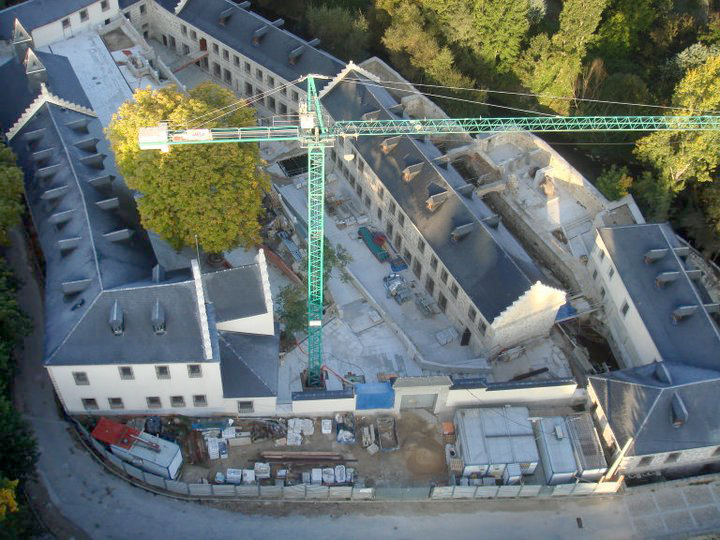
BEFORE
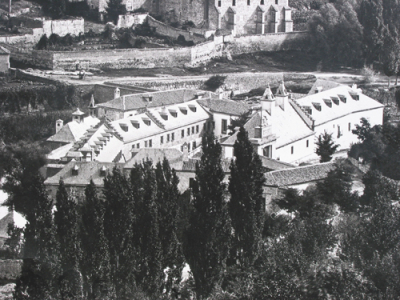
Photo: Laurent (1870). The oldest known photo of the Mint, taken one year after coining was shut down.

View on a postcard (unknown autor, 1904-1915).
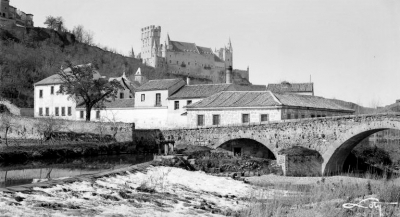
The Mint and its weir or dam (Archivo Loty, 1908-1952).
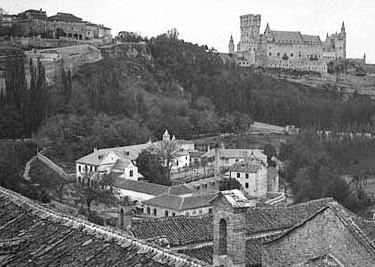
View from above the Parral Monastery (Chusseau-Flaviens, 1908-1925).
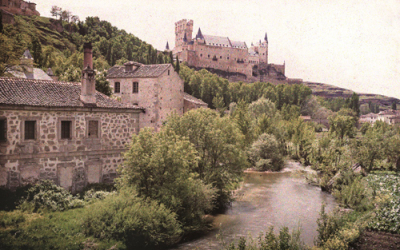
Image on a glass plate, taken from the Mint bridge (unknown autor, 1908-1915) [Alfonso Ceballos-Escalera Gila].
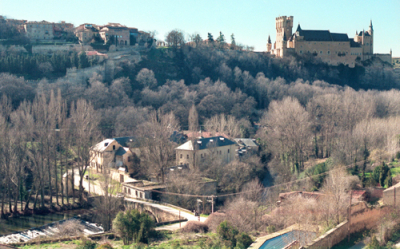
View from above the Parral Monastery (G. Murray, 1988).
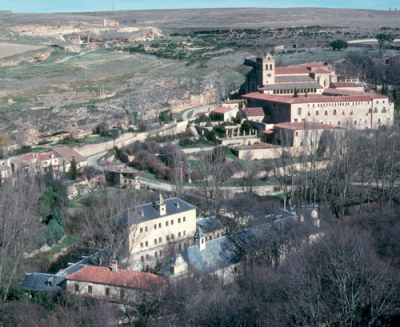
View from near the Alcazar castle (G. Murray, 1988).

Aerial view (Paisajes Españoles, 1993).
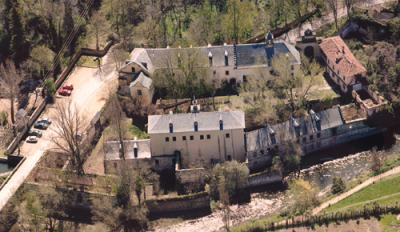
Aerial view (Paisajes Españoles, 1993).
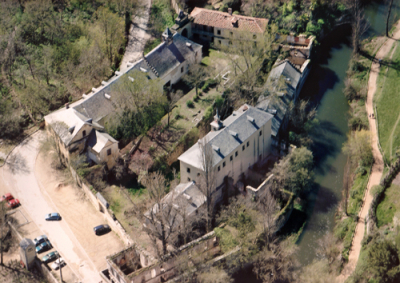
Aerial view (Paisajes Españoles, 1993).
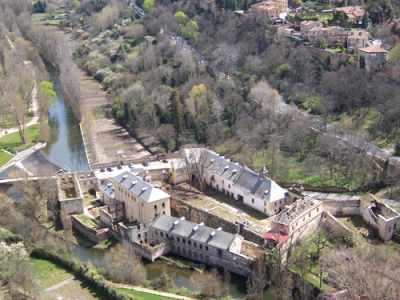
Aerial view (Sancho González-Green, 2004).
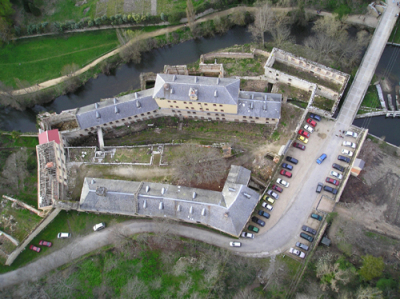
Aerial view (José Luis Martín Mayoral, 2005).
AFTER
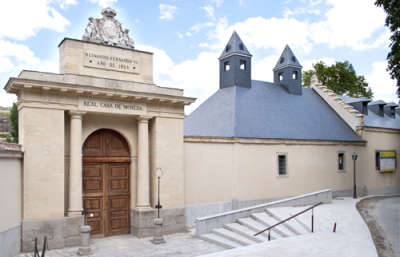
Monumental entrance and lanterns or chimneys of the foundry, seen from Mint Street. (G. Murray, 2011).
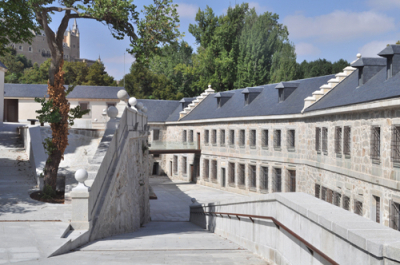
Upper and lower patios as seen from the side entrance. (G. Murray, 2011).
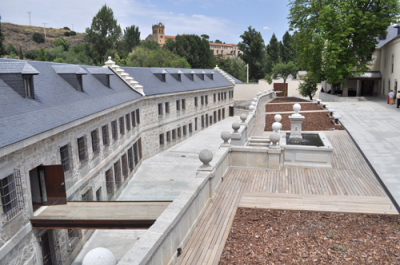
Upper and lower patios, with the fountain and silver merchant’s bridge. (G. Murray, 2011).

Coin convention in the Mint; many coins return to where they were struck. (G. Murray, 11-mayo-2013).
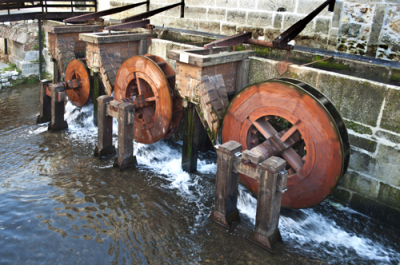
The three water wheels of the smithy. (G. Murray, 2013).
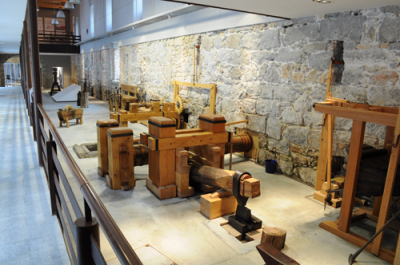
Interior view of the smithy. The water wheel axels penetrate the wall in the same place indicated by Juan de Herrera. (G. Murray, 2013).
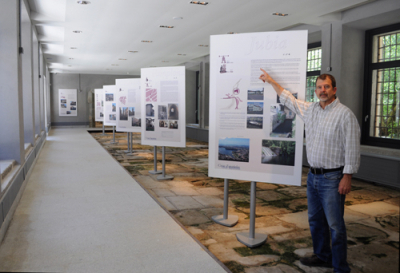
Panels in the inauguration of the Museum in 2012. (G. Murray, 2012).
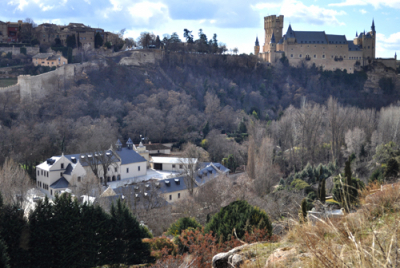
The Mint complex as seen from above the Parral Monastery. (G. Murray, 2011).
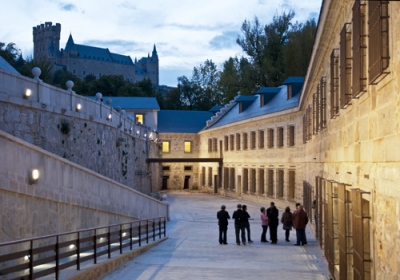
The lower patio and the ‘herrerian’ building during a night of conferences. In 2011. (G. Murray, 2011).
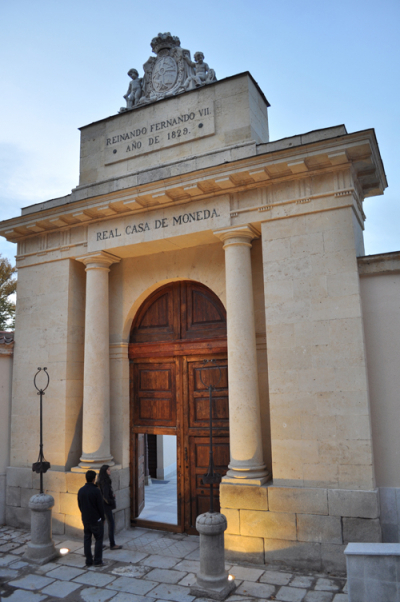
Monumental entrance. (G. Murray, 2011).
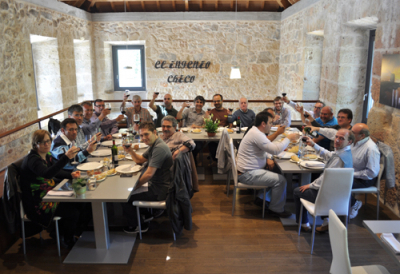
Numismatists atending the convention, eating at the Ingenio Chico restaurant. (G. Murray, 2013).
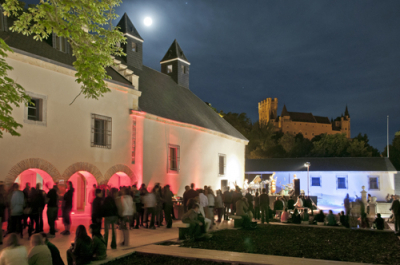
Concert and party the night of full moon, J–une of 2011. (G. Murray, 2011).
Visit the Segovia Mint
How to get there
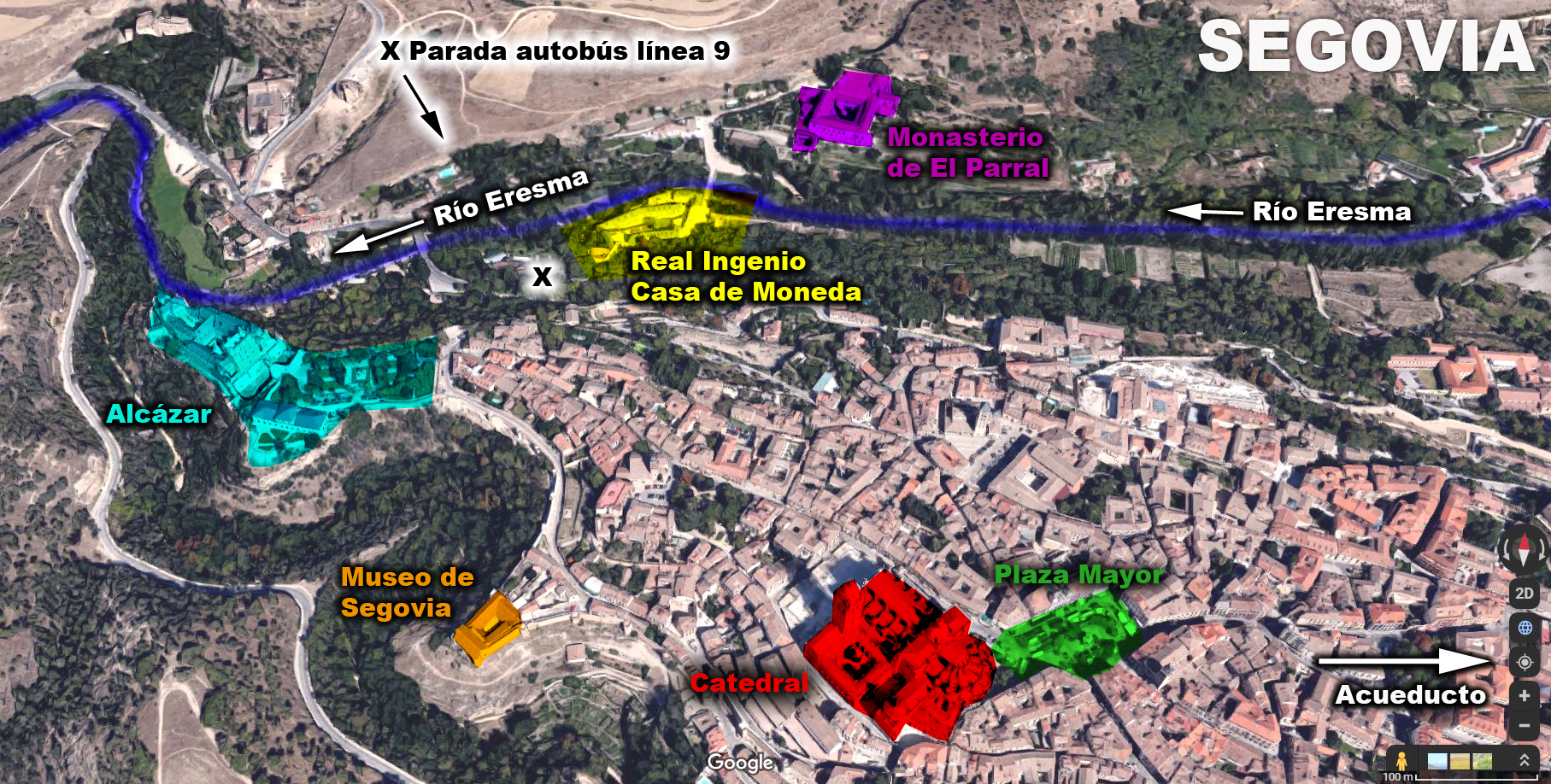
How to visit
We recommend that you first visit the three patios, and afterwards, visit inside the buildings, following the production flow route we describe below. Click on links to see images of the TECHNOLOGY used in each building, or MONUMENT for historic photos and restoration of each building.
INTRINSIC OPERATIONS. The pack mules laden with big silver bars enter the Mint through the monumental doorway, passing through security and head for the WEIGHING office. All silver which enters the factory is carefully weighed while the assayer checks the fineness of each bar in the ASSAY office. Later, the treasurer passes the silver bars to the founder, who prepares the melt, forming the alloys in the FOUNDRY. Added to the crucibles are SCRAPS AND SWEEPINGS from previous batches. The founder then passes the ingots he has made to the treasurer. This concludes the first process of minting coins, all taking place in the buildings on the upper patio level.
EXTRINSIC OPERATIONS. The treasurer later passes the silver ingots to the 'coin master', who supervises the formation of the coins in the buildings on the lower patio level. First comes METAL ROLLING where the ingots are stretched and flattened between rollers, and then pulled through the DRAW BENCH. When metal is worked, it hardens, so it is softened frequently in the ANNEALING furnace. This operation blackens the metal, which then is cleaned in an acetic bath in the BLANCHING room. In this Mint, coins are struck by the ROLLING method, SCREW PRESS or AUTOMATIC PRESS depending on the advances of each era. Coins produced with roller-dies are later punched from the strips in the CUTTING room. Using the later techniques, blanks are first cut from the strips, and then struck into coin on the presses with flat dies. Starting in 1721, an EDGE MILLING is applied to the edges of the coin. Two support departments for this process are the ENGRAVING OFFICE where the dies are engraved, and the SMITHY, where the steel rollers and dies are produced. The finished coins are then turned over to the treasurer, who formalizes the issuance of the coinage.
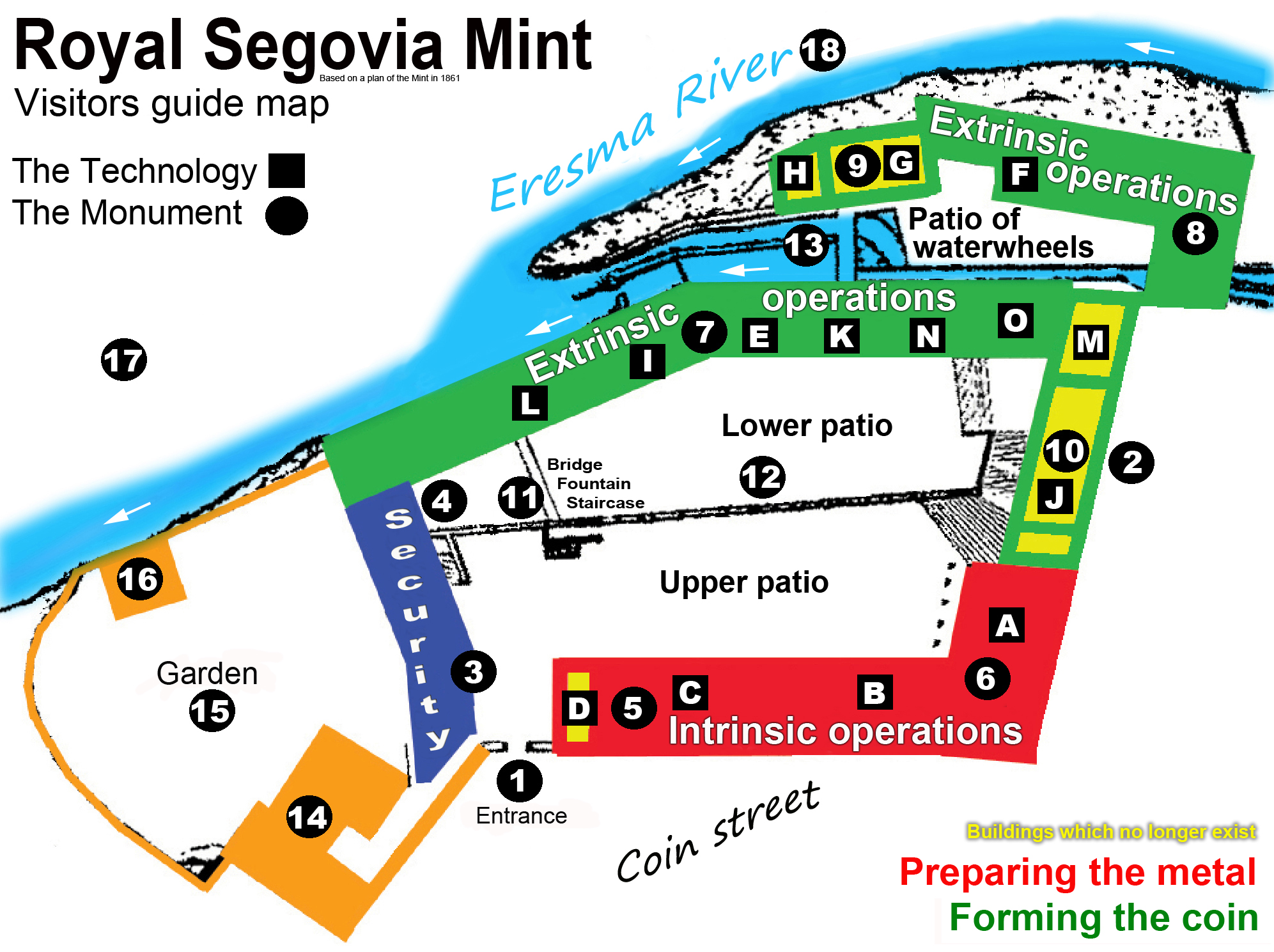
The technology 
I. Roller mill coining - J. Screw press coininge - K. Screw press coining - L. Blanking or cutting
M. Edge milling - N. Engraving office - O. Smithy
The monument 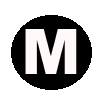
UNIQUE MONUMENTAL IMPORTANCE
THE RESTORATION PROJECT
PRODUCTION FLOW DIAGRAM
SECURITY
1. Monumental entrance
2. Side door
3. Guard and security
4. Jail
INTRINSIC PROCESSES (upper patio)
5. Foundry
6. Treasury, scales and assay offices
EXTRINSIC PROCESSES (lower patio)
7. Big mill building
8. Small mill building
9. Annealing and blanching ovens (not restored)
10. Screw press building (not restored)
OTHER PARTS OF THE MONUMENTAL COMPLEX
11. Bridge, stairs and fountain
12. Retaining wall
13. Flour mill (ruins)
14. Carpentry and treasurer’s living quarters
15. The Mint’s Garden
16. Fishing pavillion
17. Four Mint garden patches
18. ERESMA RIVER, the mint’s motor
MUSEUM INAUGURATION (2012)
CRITIQUE OF THE RESTORATION
Segovia Mint Coins
The coins are presented in chronological order and with ascending values. Values that are not known, but which may exist in accordance with current legislation, are marked with a blurred circle at the corresponding place in the 'pyramid' of pieces from each series. The series from 1455 onwards are numbered with a number and colour indicating the factory of origin.
Coin series in our catalog:
54 series Casa Vieja | 90 series Real Ingenio.
Here is the index of the PDF shown below...
COINS STRUCK IN SEGOVIA
I. COINAGE FROM MINT OF UNCERTAIN LOCATION IN SEGOVIA
II. HAMMER STRUCK COINAGE FROM THE MINT OF HENRY IV
Henry IV (1454-1474)
Alfonso of Avila (1465-1468)
Ferdinand and Isabella (1474-1504)
Joanna and Charles (1504-1516-1555)
III. SIMULTANEOUS COINAGE FROM THE HAMMER AND MILL MINTS
Philip II (1556-1598)
Philip III (1598-1621)
Philip IV (1621-1665)
Charles II (1665-1700)
IV. COINAGE OF THE MILL MINT
Philip V (1700-1724, 1724-1746)
Louis I) (1724
Ferdinand VI (1746-1759)
Charles III (1759-1788)
Charles IV (1788-1808)
Joseph I (Bonaparte) (1808-1813)
Fernando VII (1808-1833)
Charles V (pretender) (1833-1840)
Isabella II (1833-1868)
Provisional Government (1868-1870)
REFERENCE STATISTICS
Chronology of mints in Spain and Segovia
Charts of coin production and pieces known
Graph of activity and production by year
Most coins struck in one year: copper, silver and gold
Document sources for the statistics
CONTROL AND TRACEABILITY
Assayers
Mintmarks
Year of issue
Coining technology
Brief technological history of coinage.
Broadly speaking, the coin has been hammered since its invention around 640 BC until even beyond the 16th century. In 1551, German technicians invented a process by which metal was flattened and drawn in a hydraulic rolling mill with two parallel rollers, and then stamped on the metal using the same process. Hydraulic mills were introduced in Segovia in 1585, having previously been established in 13 other mints in Germany, England, France, Austria, Slovakia, Romania, Switzerland and Poland. At the end of the 16th century, other types of presses were invented, such as the Taschenwerk (rocker press) which was used in small mints throughout Europe. The flywheel press, drawn by Leonardo da Vinci, began to spread around the middle of the 17th century and was installed in Madrid, Seville, around 1700, in the Indian Mints between 1732 and 1769, and in Segovia in 1772. Sometimes two or even three different techniques were used simultaneously in some mints. All the mints in the world that survived the centralisation of governments adopted automatic minting presses from the mid-19th century, and today there are models that can mint up to 800 coins per minute.
The industrial processes used in the mass production of currency - under strict regulations and for the state - have always been one of the most complex and exact in the history of industry until the beginning of the Industrial Revolution during the second half of the 18th century. The Royal Mill Mint (1583) was the 14th mint to be mechanised when this conversion began in 1551. The fact that it is the largest, most advanced and most complete mint still standing indicates that the Segovia plant is the first testimony of a modern industrial plant. You can read about this thesis in the book by Dr. Glenn Murray, recently presented by the Chamber of Commerce of Segovia, with the title "The Royal Mill Mint, the oldest, most advanced and complete industrial factory still standing - World Heritage".
Description of the industrial processes for coining.
WEIGHING
Weighing of the metal being coined has been done since minting began in 640 B.C. There many different types and sizes of scales.
ASSAY
The assayer controls the fineness of all metal being processed, by assaying samples in his small oven. His symbol appears on each coin as a guarantee.
FOUNDRY
Melting of the metal takes place in giant crucibles over blazing charcoal. The liquid alloy is then poured into molds to form small ingots.
SCRAPS AND SWEEPINGS
Scrap, clippings, filings, defective coins and sweepings from all departments are carefully controlled by weight, for recycling in a future melt.
METAL ROLLING
Since ancient times, mints used hammers to pound out sheets of metal. In 1551 Germans invented a rolling mill for flattening and stretching metal.
DRAW BENCH
The draw bench was introduced into Spanish mints at the same time as screw presses starting in 1728. The machine is used to stretch and flatten metal.
ANNEALING
Metal hardens as it is being worked. To restore ductility, metal is annealed, or heated glowing red in a special oven and then allowed to cool slowly.
BLANCHING
Metal blackens in the annealing process. Before the final striking, the metal is blanched in a bath of hot acid and dried, so the new coin will shine.
HAMMER COINING
System invented in 640 B.C. to produce earliest coinage. Ubiquitous in mints worldwide, this technique endured until 1773 in Spanish coinage.
ROLLER MILL COINING
Coining with roller dies was invented in Germany in 1551. Introduced in Segovia in 1585, this system was used by some mints in Europe until 1770.
ROCKER PRESS COINING
The rocker press was invented in Germany and uses curved dies. It was used at many European mints from 1598 to 1790, as shown by dies known today.
SCREW PRESS COINING
Screw press coining avoids the defects caused when minting with curved dies. This press becomes popular in mints worldwide between 1650 and 1850.
AUTOMATIC COINING PRESSES
Installed with steam engines in mints worldwide starting around 1850, these machines have automatic blank feeders which allow for very rapid coining.
COINING IN MOLDS
In rare instances, molds have been used to produce coins. The main disadvantage to this method is that it produces coins very easy to counterfeit.
OTHER TYPES OF COINING PRESSES
During the 18th and 19th centuries other types of machines were invented to either strike coins or cut blanks from strips, such as the drop press.
BLANKING OR CUTTING
Since antiquity, blanks were cut with sheers, from strips of metal previously flattened by hammer, then rounded. The blanking machine dates from 1551.
EDGE MILLING
The edge milling machine was invented in 1679 and installed at the Paris Mint in 1686. In 1707 the French inventor introduces his machine in Spain.
ENGRAVING OFFICE
One of the most important departments of a mint. It requires an achieved specialist not only in engraving but also in metallurgy, to harden the dies.
SMITHY
Specialized department for producing cylindrical rollers used in the laminating mills. Contains forge, bellows, giant drop hammer, and metal lathe.
VARIOUS MISC.
In this category we include images that don't coincide with the above listing, but that we feel are of interest.
World Mints since 1500
In this section we offer the beginning of a list of Mints around the world that have operated or continue to operate since the beginning of modern times (1500). This inventory is being developed in collaboration with TICCIH (the International Committee for the Conservation of the Historical and Industrial Heritage). This is a major project that will last many years. Only those Mints for which we have some kind of data will appear on this list. As we get more data, we will expand the list. We intend to make this a platform accessible to all so that among many people, from many countries, we can develop the inventory.
Mint / Cities
Countries
Do not hesitate to participate by sending us your contributions, be they photos or any other relevant data to info@segoviamint.org
Main data we are looking for
Photographs of the building, its remains, or where it was located.
Old plans or drawings of the building or its location.
Dates of the first and last coinage in the aforementioned building.
Technology used (hammer, machine type, etc.).
Current use of the building, and whether or not it is possible to visit.
Studies and research
This page has two parts. In the first, we explain the studies and research that the Association is carrying out. In the second part, we offer our powerful document search engine so that you can carry out your own research.
Our investigations
The Association is carrying out several investigations which we feel essential for obtaining didactic content for the Segovia Mint Museum. In the first series of studies, we are attempting to locate, photograph and document all the old minting machines and related instruments which we are able to find in museums around the world. So far, we have visited Germany, Italy, Austria, France, Czech Rep., Hungary, Romania, Slovakia, Mexico, Peru and Bolivia, all very rich in material to study. Our team is made up of experts like Glenn Murray (president of the Segovia Mint Association), Volker Benad-Wagenhoff (Technoseum, Mannheim, Germany) and Andreas Udo Fitzel (numismatic investigator, Stuttgart, Germany). A selection of photos from our image bank can be seen in the section on 'Technology'. Below are photos or our team at work photographing roller dies in the Maximillian Museum in Augsburg, Germany. We appreciate information and photos from others as well.
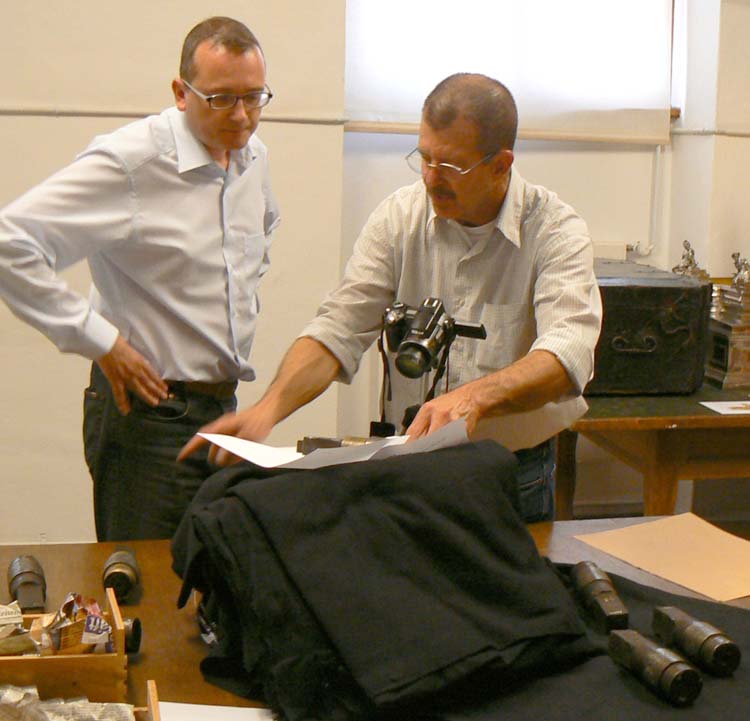
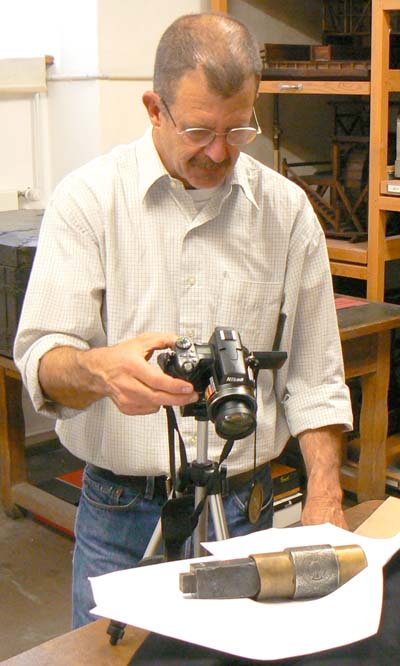
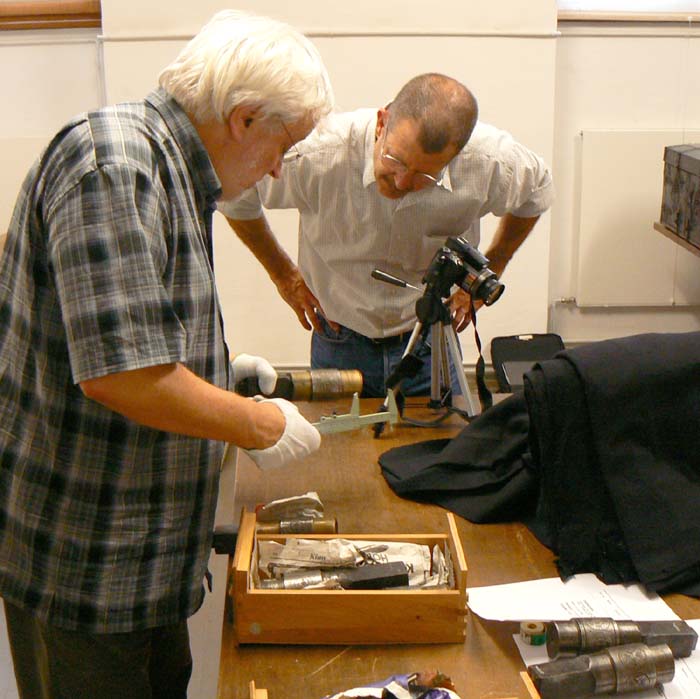
The other part in our series of investigations comes from our effort to locate, photograph and document the old mint buildings which still remain standing in Europe. While the majority of these old buildings have disappeared, some have been converted into museums of the mints, while in other cases the buildings have been converted into restaurants, shops, or offices. We are placing special emphasis on locating the 14 mints which were mechanized immediately after the invention of the roller die process in Augsburg, Germany, in 1550, and the construction of the Royal Mill Mint in Segovia in 1583, and the installation of its machinery in June of 1585. These mints are:
Augsburg (Germany) 1550
Paris (France) 1551
Zurich (Switzerland) 1558
London (England) 1562
Heidelberg (Germany) 1567
Hall in Tyrol (Austria) 1567
Köln (Germany) 1568
Augsburg [again] 1572
Dresden (Germany) 1574
Kremnica (Slovakia) 1577
Gdansk (Poland) 1577
Baia Mare (Rumania) 1579
Nyköping (Sweden) 1580
Magdeburg (Germany) 1583
Ensisheim (France) 1584
Most historic mints in Europe, to a large degree, have completely disappeared and been forgotten. In some cases, the only reminder that a mint was once there is the name of the street: Via della Zecca, Munzstrasse, Calle de la Moneda, etc. Nevertheless, we consider it important to identify the location and photograph the place where the mint once stood, so as to help the local population remember this part of their history, as well as being of interest to numismatists. This project to identify and photograph historic mints in Europe is the continuation of the work done by Glenn Murray in the EuroMint Project (2002) to locate and photograph historic mints in Spain, a work which was published in book form titled 'Guide to Spanish Mints'.
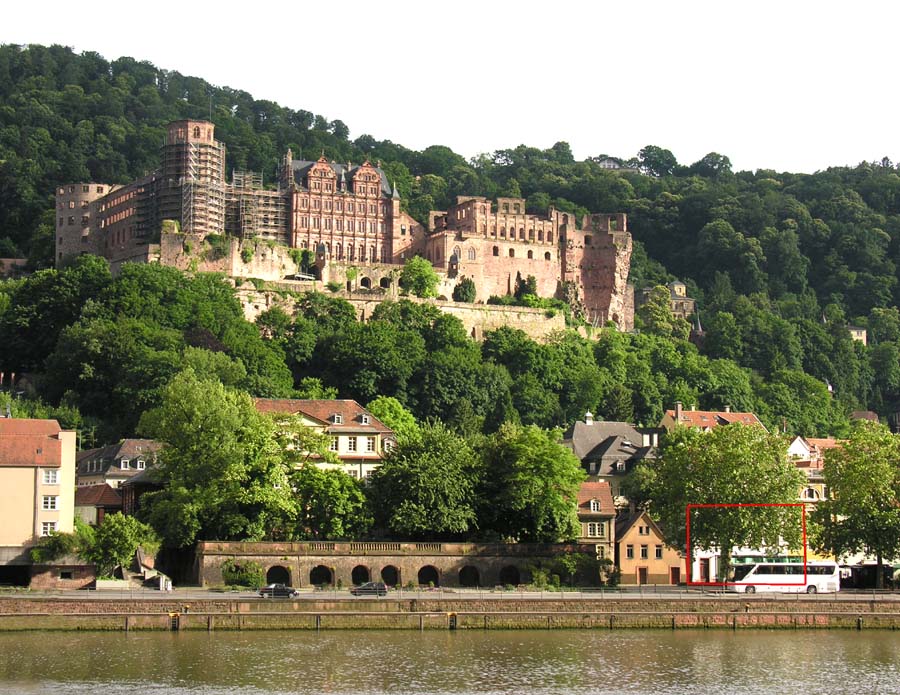
Heidelberg (Alemania) - 1567.

Hall en Tirol (Austria) - 1567.
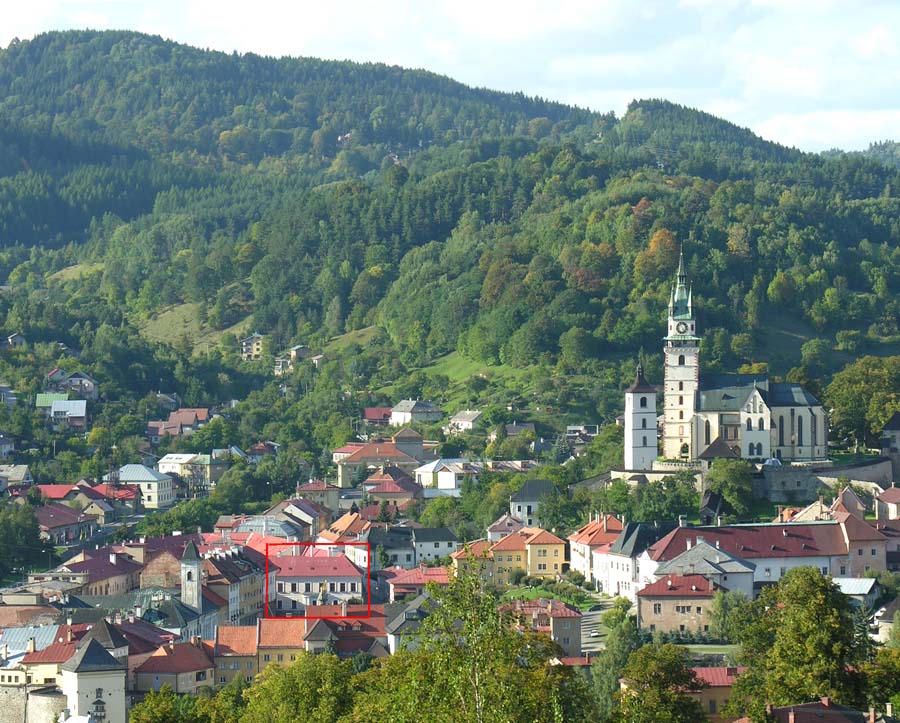
Kremnica (Eslovaquia) - 1577.
C.J.H. (Council and Boards of Finance)
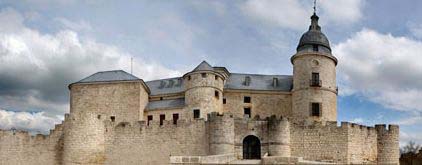
The General Archive of Simancas, in the Province of Valladolid, Spain.
Looking for published material on the Segovia Mint, other mints, or Spanish monetary policy in general?
Access to C.J.H.
Your investigations
The Association has posted on internet a search engine which gives users access to our own data base of historic documents. This data base, only available on our website, was formulated by Dr. Glenn Murray, through a grant over a ten year period, from the Spanish National Mint. Murray personally inspected page by page 1,705 document bundles from the section ‘Consejo y Juntas de Hacienda’ (C.J.H.) to find the documentation, for which he made up 6,136 individual files. This is one of the most important documentation sources for coin minting, mints, and monetary policy of Spain, during the 16th and 17th centuries.
Books and publications

HOW TO PURCHASE OUR BOOKS
Published 06/05/2023 00:00
You can purchase our publications in bookstores, coin stores, or directly from the Association. [ORDER FORM HERE]

GUIDE to documents on COINS, MINTS and MONETARY POLICY in the section Consejo y Juntas de Hacienda of the Simancas Archive
Published 05/04/2023 00:00
The Association is now distributing the inventory of documents that Glenn Murray prepared for the Madrid Mint Foundation (RCM-FNMT) between the years 1989 and 2001, of one of the sections of the Simancas General Archive: Consejo y Juntas de Hacienda (CJH). The inventory is made up of 6,135 individual entrys, comprising 2,101 pages, running from the year 1512 until 1705, which can be downloaded free of charge. (download free)

NEW FREE PUBLICATION: “Proposal for the reactivation in 1750 of the hydraulic Mint in Cuenca”
Published 07/03/2022 00:00
The mechanized Mint at Cuenca was built in 1661, using as a technological model Phillip II’s hydraulic Mint in Segovia. This proposal, dated in 1750, includes a detailed description and inventory of everything needed to put the Mint, closed and striped of machinery in 1728, back in operation. The author was the partner in Cuenca of Nicolas Peinado, engineer in charge of mechanizing the Mexico Mint in 1730. The document is an important link between these mints as well as the Potosi Mint, whose rolling mills were built in Seville in 1750. [Download free]

THE CONSTANT DECLINE IN THE CARE OF HAMMER STRIKING SPANISH SILVER COINS. Murray's conference in Cartagena, Colombia
Published 02/12/2021 00:00
In his conferencia in Cartagena, Colombia, during the 3rd Numismatic Mega-event Cartagena 2021, Dr. Murray analizes the reasons that caused the decline in the form of coins struck by hammer at Spanish mints, the consequences and the solutions which finally put an end to the problem. Of special interest is an effort to solve this problem made in 1610, headed up by Diego de Astor, the inventor of the giant 50 real pieces, and engraver at the Segovia Mint, after which the Treasury retracted its order, and 'authorized' the rapid striking of deformed coins so as not to delay the king´s payments. [download free]

THE SCANDAL OF THE 1622 CINCUENTIN, by Glenn Murray (© 2021)
Published 26/10/2021 00:00
A true history taken directly from the historical documents, about influential segovians and their experiences in the two Segovia Mints during the bonanza period of the principal industry of the city: coining. [Download free]

THE EFFECTS OF THE ‘GREAT SCANDAL OF POTOSI’ IN SPAIN, by Francisco Jovel y Roberto Jovel (© 2003)
Published 15/09/2021 00:00
Article written by Francisco Jovel and Roberto Jovel, especially for the website of the Friends of the Segovia Mint Association, where it appeared on May 9, 2003. We now present this work in pdf format, which can be downloaded and shared. [Download free]

AUCTION AND SALE OF THE OLD MADRID, SEVILLE, SEGOVIA AND JUBIA MINTS (1866 - 1870)
Published 05/09/2021 00:00
Our latest pdf is free to download, share and print. The auctioning of the old mints at Madrid, Seville, Segovia and Jubia (1866-1870). With interesting decriptions of the buildings. We launch this new publication in commemoration of the 16th anniversary of the signing of the restoration agreement for the restoration of the Segovia Mint on September 5, 2005. [Download free]

GUIDE TO MINT PRODUCTION DOCUMENTS IN THE SIMANCAS ARCHIVE
Published 22/04/2021 00:00
Our publication for 2021 is this guide to the accounting documents of mints in the General Archive of Simancas. We conisder this an authentic treasure map for research on all aspects of Spanish peninsular mints and truly hope it serves to inspire investigaions by collectors and historians alike. This guide can be downloaded, used and shared free of charge for everyone. [DOWNLOAD FREE]

THE CONSTRUCTION OF THE ROYAL SEGOVIA MILL MINT, AS SEEN THROUGH THE ACCOUNTING LEDGERS
Published 13/12/2011 00:00
BOOK PUBLISHED BY MEMBER OF FRIENDS OF THE SEGOVIA MINT. Detailed description of the construction and first coining in the Royal Mill Mint, according to account ledgers by the Mint\\\'s treasurer and the project supervisor, in T.M.C. -906 of the Simancas Archive. PUBLISHER: Obra Social y Cultural de Caja Segovia. AUTHOR: Miguel Ángel Cillanueva de Santos. © 2011, 15x21 cm, 318 pgs. Dep. Legal: SG-185-2011. ISBN: 978-84-92432-64-6. (PVP: 20€). [BUY HERE]

PEDRO HARTENBECK (1550-1616) - GERMAN ENGRAVER IN SEGOVIA
Published 18/10/2007 00:00
BOOK PUBLISHED BY MEMBER OF FRIENDS OF THE SEGOVIA MINT [in German]. Detailed study about the German engraver Peter Hartenbeck, who came to Segovia in 1584 with the minting machinery convoy, engraved the first roller dies, and stays at the Mint until 1595, when he returns to Tyrol and engraves in that Mint until he dies in 1616. PUBLISHER: Schwäbisch Gmund City Hall. AUTHOR: Andreas Udo Fitzel. © 2007, 17x24 cm. 96 pgs. ISBN: 978-3-936373-32-5. (PVP: 25€) [BUY HERE]

THE FOUNDING OF THE ROYAL SEGOVIA MILL MINT - FROM THE INITIAL IDEA UNTIL THE FIRST COINS
Published 01/01/1990 00:00
\"…as seen through 43 documents from the Simancas Archive\". Complete transcriptions of the most important documents: letters from Juan de Herrera, deed title for purchase of mint, convoy of machinery brought from Tyrol, first test coins, etc. In Premios Mariano Grau, convocations 1989-1990, pgs 355-534. PUBLISHER: Academia de San Quirce. AUTHOR: Glenn Murray. © 1997, 15x21 cm. Dep. Legal: SG-130/97. [AGOTADO]

THE ROYAL MILL MINT OF SEGOVIA - OLDEST, MOST ADVANCED AND COMPLETE INDUSTRIAL FACTORY STILL STANDING TODAY...
Published 14/02/2009 00:00
"…Scientific justification for the proposal that the Mint be declared Industrial Heritage of Mankind". The unique characteristics of the Mint are analyzed in their time and spatial context, and the requirements of the UNESCO are considered point by point. PUBLISHER: Segovia Chamber of Commerce and Industry. AUTHOR: Glenn Murray. © 2009, 21x29 cm, 90 pgs. [FREE HERE]

COINS OF THE ROYAL SEGOVIA MILL MINT - Collection of coins struck in Segovia
Published 22/02/2007 00:00
Brief history of the Segovia Mill Mint, with a collection of 15 silver plated medals of historic coins, distributed by the newspaper to commemorate the start up of the Mint restoration process. PUBLISHER: El Adelantado de Segovia. AUTHOR: Glenn Murray. © 2007, 20x28, cm. [OUT OF PRINT]

Antonio Beltran and the Royal Mill Mint of Segovia
Published 01/01/2007 00:00
Pages 360 - 394, direct link.

The rejection of the perfect coins from Segovia - Philip II's fraud and the coin clippers in Genoa
Published 01/01/2001 00:00
Pages 173 - 179, direct link.

Consejo y Juntas de Hacienda as a documental source for numismatics and monetary policy (1512-1700)
Published 01/07/1996 00:00
Pages 286 - 305, direct link.

Guide to the quantity of coins struck in the Mints of Castile - I. Philip II, silver and gold
Published 01/01/1995 00:00
Pages 203 - 239, direct link.

Genesis of the Royal Segovia Mill Mint - IV. Transport of the machinery and first trial coins
Published 01/07/1994 00:00
Pages 85 - 119, enlace directo.

Genesis of the Royal Segovia Mill Mint - III. The Construction of the buildings (1583-1588)
Published 01/01/1994 00:00
Pages 111 - 151, direct link.

Guide to the quantity of coins struck and assayers at the Madrid Mint (1615-1868)
Published 01/07/1993 00:00
Pages 295 - 387, direct link.

Genesis of the Royal Segovia Mill Mint - II. The Search for a Place to Build the Mint (1582-1583)
Published 01/01/1993 00:00
Pages 177 - 222, direct link.

The Royal Mill Mint of Cordoba - transcriptions of documents to honor the discovery of this modern mint by Antonio Orol, in his memory
Published 01/01/1992 00:00
Pages 313 - 342, direct link.

Assayer Sebastián González de Castro, and the techniques used to strike billon at the Old Hammer Mint and the Royal Mill Mint in Segovia, 1660-1664
Published 01/07/1991 00:00
Pages 105 - 126, direct link.

Genesis of the Royal Segovia Mill Mint - I. The idea (1574-1582)
Published 01/01/1991 00:00
Pages 59 - 80, direct link.

THE MINTS OF SEGOVIA AND HALL IN TYROL
Published 22/05/2007 00:00
Compendium of articles by several authors about both Mints, as part of a partnership project. Murray explains the “Musealization Directive Project for the reconstruction of the artisan workshops for the future Mint museum” in pgs. 253-282. EDITA: Segovia City Hall. AUTHORS: Varios. © 2007, 20x26, cm, 301 págs. Dep. Legal: M-21677-2007. ISBN: 978-84-931589-7-2. (PVP: 20€). [OUT OF PRINT]

THE ROYAL MILL MINT OF SEGOVIA - TECHNOLOGICAL MARVEL OF THE 16th CENTURY
Published 19/05/2006 00:00
Detailed analysis of the technological history of the Mint, study on which the ‘Musealization Directive Project (2004) for the restoration was based, and which won the “International Garcia-Diego Prize”. PUBLISHER: Fundación Juanelo Turriano. AUTHORS: Glenn Murray, José María Izaga and Jorge Soler. C 2006, 23x27, cm, 374 págs. Dep. Legal: M-13433-2006. ISBN: 84-920755-3-8. (PVP: 40€). [BUY HERE]

HISTORY OF THE ROYAL SEGOVIA MILL MINT AND THE PROJECT FOR ITS RESTORATION
Published 04/05/2006 00:00
Brief history of the Mint and its coins, with descriptions and explanations of the four projected workshops for live artisan production in the future museum of the restored building. PUBLISHER: Royal Segovia Mill Mint Foundation. AUTHOR: Glenn Murray. © 2006, 22x28 cm, 120 pgs. Dep. Legal: M-5874-2006. ISBN: 84-609-8974-7. (PVP: 15€). [OUT OF PRINT]

GUIDE TO THE SPANISH MINTS - 18 MINTS + Euromint partners
Published 12/03/2003 00:00
The first and only guidebook ever written about the precise location of each of the 18 Spanish Mints, with the intention of promoting a “European Mint Itinerary”, goal of the European EuroMint Project. EDITA: Proyecto EuroMint. AUTOR: Glenn Murray. © 2003, 23x23 cm, 51 pgs. Dep. Legal: SG-12-2003. (PVP: 0€) [OUT OF PRINT]

THE COINS OF SEGOVIA - History of Coining in Segovia from 30 B.C. to 1868
Published 11/11/2002 00:00
Fun comic of the history of coining in Segovia. PUBLISHER: EuroMint Project. AUTHORS: Glenn Murray and Jose Orcajo. © 2002, 21x28,5 cm, 16 pgs. (PVP: 0€). [Editions in Spanish and English]. [OUT OF STOCK].

COINS STRUCK IN SEGOVIA FROM 30 B.C. TO 1868...
Published 14/02/2012 00:00
“In Commemoration of the Royal Segovia Mill Mint Restoration, 2007-2011”. Photos of all the types of coins struck in Segovia, with historical description of each series and the 4 coining techniques used. PUBLISHER: Friends of the Segovia Mint Association. AUTHOR: Glenn Murray. © 2011, 15x21 cm, 99 pgs. Dep. Legal: SG-204-2011. (PVP: 6€). [OUT OF PRINT]

MADRID MINT - MINTAGE STATISTICS AND ASSAYERS...
Published 07/11/2014 00:00
“…1614-1868. In Commemoration of the 400th Anniversary of its foundation in 1614”. Contains mintage statistics for each coin type by year (1615-1868), production charts, history of each assayer, and lots more. PUBLISHER: Friends of the Segovia Mint Association. AUTHOR: Glenn Murray. © 2014, 15x21 cm, 187 págs. [455 grs.] Dep. Legal: SG-304-2015. (PVP: 12€). [BUY HERE]

GUIDE OF MINTAGE STATISTICS - POTOSI AND LIMA MINTS - GALANOS...
Published 22/10/2016 00:00
“…A Synthesis and Mathematical Conversion of Work by Carlos Lazo García, with Special Section on Galanos, in memory of Carlos Lazo García”. Contains mintage statistics for each coin type by year (1568-1825), production charts, history of the mints, and lots more. PUBLISHER: Friends of the Segovia Mint Association. AUTHOR: Glenn Murray. © 2016, 15x21 cm, 296 pgs. [719 grs.] Dep. Legal: SG-281-2016. (PVP: 18€). [BUY HERE]

THE COINS OF SEGOVIA - From the Roman As to the Royal Segovia Mint Museum...
Published 14/02/2017 00:00
“…In Commemoration of the 10th Anniversary of ‘Segovia Mint Day’ (2007)”. New and enlarged version of our 2002 comic. Now including the history of the restoration of the Mint and the creation of the Museum. PUBLISHER: Friends of the Segovia Mint Association. AUTHORS: Glenn Murray and Jose Orcajo. © 2017, 21x28,5 cm, 20 pgs. [81 grs.] Dep. Legal: SG-387-2017. (PVP: 2€). [Editions in Spanish and English]. [BUY HERE]

ROYAL FRAUD - The Monetary Adventures of Philip II in the Royal Mill Mint of Segovia
Published 29/06/2019 00:00
Narration based on true and documented historical facts, about the construction of the Royal Mill Mint, the convoy which brought the machinery from Tyrol, and the enigmatic secrets of Philip II in his scandalous debasement scheme for coinage. PUBLISHER: Friends of the Segovia Mint Association. AUTHOR: Glenn Murray. © 2019, 15x21 cm, 296 pgs. [637 grs.] Dep. Legal: SG-159-2019. ISBN: 978-84-09-12265-3. (PVP: 18€). [BUY HERE]

THE ROYAL MILL MINT OF SEGOVIA - Guidebook to the monument and the coins struck in Segovia from 30 B.C. to 1869
Published 30/05/2018 00:00
Updated and enlarged version of our 2011 book. Contains photos of all coins struck in Segovia, production statistic charts, guide to the mint buildings, and lots more. PUBLISHER: Friends of the Segovia Mint Association. AUTHOR: Glenn Murray. © 2018, 15x21 cm, 129 pgs. [377 grs.] Dep. Legal: SG-108-2018. (PVP: 8€). [BUY HERE]
Contact
Here you have all the data to contact us or you can fill in the following form to contact us...
Our headquarters
C/ Los Zuloaga, 3, Bajo - C, 40001, Segovia, ESPAÑA
Sending correspondence
Apartado de Correos 315, 40080, Segovia, ESPAÑA
ContactPhones
Phone: (+34) 921 420 921
Mobile: (+34) 652 277 300
